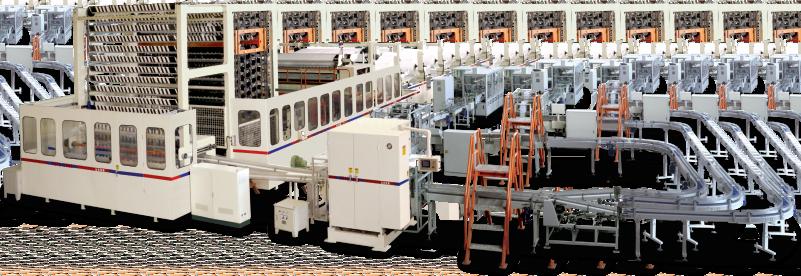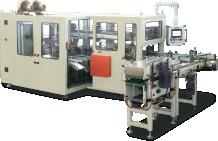The independent news provider for the global tissue business
NORTH AMERICA
On the brink of a new era
MARKETISSUES
Sustainability: As the industry advances, where will future key inroads be made?
PULP: TECHNICAL THEME
Canfor: C$250m to reduce GHG
UPM: $3.47bn investment largest in its history
EXITISSUES
The tissue facts on the ground … seeing the forest, and the trees
Plus....
July/August 2023 | Issue #4
YOUR SINGLE SOURCE FOR TISSUE
THE GLOBAL LEADER IN TISSUE
The Power of Leadership
Since 1976, Convermat has been the leading global supplier of parent rolls of tissue to more than 80 countries worldwide. Our unparalleled market intel and strong network of strategic alliances, resources, and insider knowledge can further grow and strengthen your business to achieve higher profits.

There When You Need Us
We consistently maintain capacity balance for many of the leading global tissue players. Our extensive network of global suppliers and customers enables us to deliver a continuous flow of tissue at the most competitive prices in any market condition and to any destination with speed, reliability, and integrity.
At Your Service
Our experienced team of seasoned professionals is equipped to handle all of your needs including inland and ocean transportation, import/export protocol, technical specifications, testing lab facilities, proprietary product development, foreign currency management, credit risk, and all relevant sales services.
More Than Tissue
In addition to our complete line of tissue, towel, napkins, and specialty paper we supply a comprehensive line of nonwoven substrates for medical, wipes, automotive, filtration, hygiene applications, and more.

www.convermat.com
T: 516.487.7100
F: 516.487.7170
Bath Tissue | Facial Tissue | Napkins | Kitchen Towel | Industrial Towel | Center Pull Towel | TAD Bath and Towel | NTT Bath and Towel | Carrier and Specialty Tissue | Airlaid | Nonwovens | and more
IN THIS ISSUE...
03
04
08
18
24
28
34
38
42
FRONTISSUES
The global tissue leader is coming to terms with new world trends across North America.
MARKETISSUES
Our journeys toward net zero: leading companies explain their priorities and ambitious targets. Consumer Markets Analyst Simon Creasey reports.
NEWS IN BRIEF
A roundup of news from across the global tissue industry. To get the very latest news go to www.tissueworldmagazine.com.
REGIONAL REPORT: NORTH AMERICA
Is the tissue consumption leader about to enter a new market era? By Fisher International.
REGIONAL REPORT: NORTH AMERICA
The uneven post-pandemic recovery continues and essential products dominate, as emerging trends reinforce the urgency needed to reassess supply chain efficiency. Euromonitor International’s Head of Tissue and Hygiene Liying Qian reports.
OPERATIONS REPORT: KRUGER PRODUCTS
Margin recovery, strong top-line growth, ramped up production ... a market leader reports from The Great White North and U.S. Kruger Products speaks to TWM.
OPERATIONS REPORT: ST PAPER
The low capital dynamic: re-utilise shut or under-used facilities … and build in flexibility for multi-choice directions. TWM interviews Senior Vice President and Chief Operating Officer Ron Thiry.
PULP: TECHNICAL THEME
Canfor Pulp: A global pulp leader is investing at least C$250m to reduce its GHG emissions, and plans to undergo the Science Based Targets initiative validation in 2024. A TWM report.
PULP: TECHNICAL THEME
UPM’s $3.47bn investment is largest in its history. ‘Step change’ project includes new pulp mill in Paso de los Toros, a new terminal at Montevideo’s deep sea port, community developments in housing, landfill and waste water treatment... and a more than 50% increase in pulp capacity. A TWM report.
47
EXITISSUES
The tissue facts on the ground … seeing the forest, and the trees. Industry analyst Greg Grishchenko - comparing the reality to sometime public perception - reveals just how responsible the industry has been with its forestry and bleaching programmes.
50 AD INDEX
July/Aug | 1 www.tissueworldmagazine.com Tissue World Magazine | Contents
PULP & PAPER REDUCTION OF CO 2 EMISSIONS WITH
Prime Line TISSUE TECHNOLOGIES AND SERVICES
Our challenge as a technology partner to the tissue industry is not only to offer solutions for conserving energy and raw materials within the mill complex, but also to offer solutions that help mitigate or replace GHG emissions from “upstream” sources of fiber, electricity, water and chemicals. Modifying the

approach flow system, high-performance roll covers, shoe presses, insulating the heads of the Yankee, and heat-recovery steam generator systems are just some examples of our broad portfolio.
For further information, please contact us at tissue@andritz.com
ANDRITZ AG ⁄ Stattegger Strasse 18 ⁄ 8045 Graz ⁄ Austria ⁄ andritz.com/tissue
EDITORIAL HEADQUARTERS
Informa Markets – UK
240 Blackfriars Road, London, SE1 8BF, UK
Tel: +44 (0)20 7017 5000
Group Director
Chris Edwards: chris.edwards@informa.com
Senior Editor
Helen Morris: helen.morris@informa.com
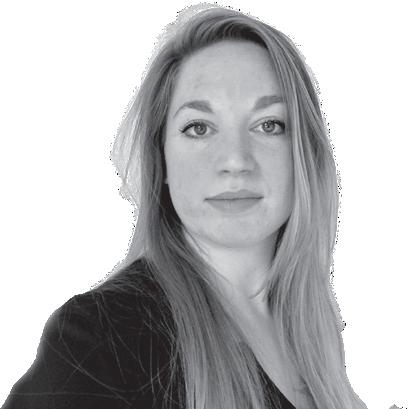
Event Director & Publisher
Tom Hill: tom.hill@informa.com
Executive Director
Chris Kilbee: chris.kilbee@informa.com
CEO
Margaret Ma Connolly: margaret.connolly@informa.com
ADVERTISING ENQUIRIES
Europe & North America
Silvio Arati
T: +39 02 4851 7853 sarati@studioarati.it
South and Central America
Selma Ugolini
T: +55(11)99904 5350 selma@gova.com.br
China, Hong Kong & Macau
Jennie Zhan
T: +86 20 86660158 info-china@informa.com
TISSUE WORLD MAGAZINE is published bi-monthly. The subscription price is US$400 per year for 6 issues. Subscription is free for qualified subscribers in the tissue industry.
Please send address corrections to:
Informa Markets – UK
240 Blackfriars Road, London, SE1 8BF, UK Tel: +44 (0)20 7017 5000 info@tissueworld.com
Subscription online at www.tissueworldmagazine.com
In Tissue World all measures are metric and all dollars ($) are US dollars, unless otherwise stated. Copyright 2022 by Informa Markets – UK. All rights reserved. All materials printed in Tissue World Magazine is owned by Informa Markets – UK and protected under the copyright act. No material may be reproduced in part or in whole without the prior written consent of Informa Markets – UK.
TWM’s various analyses of the fluctuations in the North American tissue market make clear the more fundamental and longer-term changes now underway. It is a big statement to suggest we may be on the brink of fundamental changes in the region, dominated by the consumers who use far and away the most tissue per capita.
Some of the major points in our North American Regional Report include a “dilution of producers’ market power” from “traditional concentrations,” which is driving “consolidation and closures” in the US, with quality or cost requirements dictating.
Many new producers including Essity, Sofidel, and First Quality Tissue have been attracted. Opportunities are also opening for SME’s offering smaller scale products, and the serial turbulence of recent years has shaped a “less carefree and more price aware” consumer. The favoured mechanism is “switching to cheaper brands, buying smaller packages or simply cutting back.” The surprise is the scale on which that is happening.
Private label has reached 28% – way below European levels but the direction of travel is clear. Ultra-hygiene, and issues of sustainability – carbon emissions, fibre sourcing, and product design – are factored more into consumers’ demands. This new and sharper awareness is being closely studied.
Companies have targeted “better alignment with long-term consumer demand by investing towards capacity and efficiency with a focus on high-margin, high-quality items.” The question is posed: “Could the growth of tissue consumption per capita and TAD in the US finally peak, and start to decrease with increased consumer concern about sustainability and hygiene?”
QUOTE OF THE EDITION
What does it feel like to be a tissue world champion? Well now we know. Samir Masoud, UAE Supply Chain and Operation Director, and his team at Fine Hygienic Holding’s Al Nakheel mill in Abu Dhabi reached speeds of 2,222m/min in June with a Valmet-supplied Advantage DCT 200 TM. He said: “This great achievement was reached while the machine was producing 13.2 gsm facial tissue at 96.5% efficiency. It is just amazing!” He tells you how they did it in World News.
WELCOME TO THE FIRST ISSUE OF TWM’S BRAND REFRESH!
We're still offering the great series of events and content you know and love, just with a fresh lick of paint across Tissue World’s portfolio: Miami (31 Jan – 2 Feb 2024), Istanbul (Autumn 2024), Düsseldorf (1 – 3 April 2025), and TWM.
July/Aug | 3 www.tissueworldmagazine.com Tissue World Magazine | FrontIssues
Morris Senior Editor, Tissue World Magazine
Traditional Market Power Structures Are Going Through A More Rapid Change Than For Decades As The Global Tissue Leader Comes To Terms With New World Trends Helen
OUR JOURNEYS TOWARD NET ZERO: LEADING COMPANIES
EXPLAIN THEIR PRIORITIES AND AMBITIOUS TARGETS
More stringent regulations on sustainability are on the horizon. Consumer Markets Analyst Simon Creasey reports on the biggest advances across tissue’s production sectors already underway.
Industries that intensively use energy and natural materials have increasingly been thrust into the spotlight in recent years. Initially, their actions were scrutinised by environmental campaigners, but consumers have become more conscious of sustainability issues than ever before, and today many of them are making purchasing decisions based on the eco-credentials of brands.

The tissue industry has not escaped this scrutiny, and in the past some environmental campaigners argued that the sector was awash with greenwashing. However, over the last few years the industry has arguably been pioneering when it comes to sustainability issues with many companies pushing the envelope in terms of adopting innovative approaches to sourcing new environmentally friendly materials and manufacturing processes.
So what inroads has the industry made so far and where is it focusing its future efforts? Also, what impact might looming legislation in the UK, Europe and further afield have on those companies that have failed to keep up with the industry’s environmental pace setters?
One company that’s undoubtedly led the charge in the area of sustainability is LC Paper. The 140+ year old Spanish-based business has used its sustainability credentials as a point of difference in a highly competitive marketplace, according to its General Manager Pau Vila. A key area of focus has been to move towards net zero production through energy fulfilment.
“Energy in paper making consists of two main areas: electricity and industrial heat,” explains Vila. “For electricity, the company has implemented an on-site solar plant of 4MWp with 8.500 solar panels over 20 hectares of land, which covers about one forth of the [company’s] electricity needs during daytime.”
He says that due to the electricity demands of paper making the company can’t currently utilise electricity storage systems such as batteries, so to cover non-solar hours LCA relies on alternative methods of renewable electricity fulfilment.
“This challenge was overcome through the purchasing of certified renewable energy from the grid, which includes local hydroelectric plants that produce renewable electricity even in non-solar hours, thanks to the mountainous orography of the region,” says Vila.
4 | July/Aug www.tissueworldmagazine.com
Tissue World Magazine | MarketIssues
For its heating needs, the company has implemented a high-capacity industrial biomass boiler, which is powered by residues from the forest cleaning activities over a radius of 20km around the company’s production site, which are undertaken to prevent the spread of wildfires.
“However, industrial biomass has a temperature limitation far below 500ºC, which is the temperature needed for the Yankee and hood of the tissue machines, so a different approach was fundamental for those specific areas where very high temperatures are required,” says Vila. “The technological choice was biomethane from nearby farming activities: animal residues are fermented until they become a gas suitable to reach temperatures over 500ºC without resorting to fossil fuels.”
In addition to reducing the carbon footprint of its production processes the company also invested a lot of time and effort into reducing the footprint generated by its packaging and logistics. To this end, LC Paper has completely eliminated plastic packaging from its tissue products range, by using cardboard boxes for AfH products and folding board packaging for At Home products.
The materials it uses are recycled, recyclable and compostable and offer logistic advantages such as better palletisation and stackability, which results in a reduced need of truck loads to deliver the same amount of product and, in turn, lowers emissions.
LC Paper has validated its measures through the ISO 14.067 standard and it has also achieved B Corp status. Vila said the company expects to further expand its decarbonisation efforts from the current scope one and scope two (paper making process) to scope three (full life cycle of the product, including pulp fulfilment and final distribution).
“That horizon includes joint initiatives with suppliers such as a common project with the Spanish pulp producer Ence, which develops a specific type of fibres called Naturcell Zero which have been produced under a specific low carbon pulp making process, in which the remaining emissions have been offsetted,” says Vila.

WEPA is another tissue company that takes sustainability seriously. It has launched a ‘4+1 Sustainability Strategy’.
“Our foundation is the bedrock for all this,” says a spokesperson for WEPA. “It is derived from our perception of ourselves as a responsible family business and focuses on our most important stakeholders. Our four industry-specific areas ‘future fibres’, ‘operational efficiency’, ‘sustainable hygiene paper portfolio’ and ‘portfolio extension through innovation’ build on the stable basis of our foundation.”
The company has also set itself challenging targets when it comes to increasing the amount of recycled materials and alternative materials it uses in its products in the future.
“One of our aims is to increase the share of recycled fibres and alternative fresh fibres in the raw material mix to at least 60%, thus reducing the ecological footprint of the fibres used by at least 25% by 2030. With recycled cardboard and Miscanthus, we recently introduced two raw material innovations for our hygiene products which contribute to achieving this goal.”
Poppies Europe has broken its approach to sustainability into key areas of focus. Those include developing and promoting 100% recycled products under its AfH brand Happy Trees, and reducing the fibre consumption in its virgin products.
Armindo Marques, Director at Poppies Europe, says: “Under the brand Cloud 9 we have reviewed the functional aspects of our napkins and tried to reduce the fibres needed in the product without compromising its performance. This was achieved through development of more technical material, enhanced fibres and strong marketing efforts to communicate to our customers the benefits.”
He adds that all of the company’s virgin paper is FSC accredited and the company also abides by the ISO14001 environmental management framework which defines Poppies‘ targets when it comes to energy saving.
“One effective way to save energy is to be more efficient at what you do and for that we have invested extensively in new machinery with lower consumption per tonne of tissue converted, in a
July/Aug | 5 www.tissueworldmagazine.com
Tissue World Magazine | MarketIssues
LC Paper has completely eliminated plastic packaging from its tissue products range, by using cardboard boxes for AfH products and folding board packaging for At Home products.
new industrial site for operational streamlining and of course in people development with a full skill enhancement programme,” says Marques.
In addition to improving efficiencies the company has also installed solar panels on top of all of the roofs at its 12-acre production site, which means that more than 55% of its electrical energy needs are powered by the sun.
Essity is equally ambitious when it comes to rolling out innovative approaches to new materials and efficient, sustainable manufacturing. In Germany, it has opened what it claims is the first large-scale production of pulp for tissue made from agricultural byproducts in the form of wheat straw. In Sweden its tissue plant runs on fossil-free biogas and it has also opened a green hydrogen facility in Germany.
A spokesperson for Essity says: “As a leading global hygiene and health company, we are equally committed to both social and environmental aspects of sustainability. This is reflected in our sustainability priorities where we focus on 10 topics relevant to our industry and operations. Our journey to net zero, commitment to the UN Sustainable Development goals, our science based targets as well as external factors (legislation, etc) are very important components driving our initiatives.”
Essity has set itself ambitious targets to reduce its environmental footprint over the coming years and so too has Northwood, which has set itself the goal of being net zero by 2050.
A key part of its strategy has seen the business invest in modern, energy efficient equipment. For instance, a new boiler due to be fitted at
its Northwood Tissue (Disley) mill later this year is expected to reduce CO2 by 15-20% and an upgrade to the insulation at the mill will deliver an additional 1.5% carbon saving. Northwood is also reducing the emissions of its fleet of vehicles by investing in 14 new state-of-the-art trucks and upgrading the remainder of its fleet by 2024. And that’s not all. “Over the last three years we have made great strides in reducing the amount of plastic in our supply chain,” says Joel Quick, Sustainability Manager at Northwood. “Whilst plastic will always have a place in certain product categories, we have made significant investment to replace it with more renewable alternatives. The total of our reduction initiative is currently at approximately 51 tonnes per year removed from the supply chain, in hand towels alone. Our work on this is far from complete, as we continue to look for renewable materials, higher recycled contents and better recyclability of our packaging components.”
The company has also purchased REGO backed electricity since 2019, which has reduced carbon emissions by more than 2,500 tonnes of CO2e at Northwood Hygiene alone and its Northwood Consuma Tissue division has achieved zero waste to landfill.
For those companies who have not yet risen to the challenge as rapidly as the likes of Northwood the impending threat of stringent legislation looms large on the horizon. In addition to new EU anti-deforestation regulation, the UK government recently introducing guidelines around businesses transitioning to recycled materials and away from virgin fibre tree products. There are also suggestions lawmakers in the US might adopt a similar approach.
The industry is waiting with baited breath to see how things play out, but Vila says the regulatory changes currently ongoing in the EU and UK will be a force for good as they will act as accelerators to increase the speed at which the tissue sector implements its decarbonisation strategies.
“For instance, the ETS (Emissions Trading System) scheme in which tissue producers need to pay for each ton of CO2 emitted is already a significant incentive to move away from fossilbased energy sources. Local regulations such as the plastic packaging tax in Spain also accelerate changes in the products’ composition, packaging and production processes,” says Vila.
Poppies’ Marques agrees, but says that when it comes to sustainability a balance needs to be struck between regulatory measures and free market trade.
“In the UK the AfH market has sorted out the question of the use of recycled fibre a long time
6 | July/Aug www.tissueworldmagazine.com
Tissue World Magazine | MarketIssues
For those companies who have not yet risen to the challenge as rapidly as the likes of Northwood the impending threat of stringent legislation looms large on the horizon.
ago, but nevertheless, there is still a big effort to be made to process some qualities of recovered papers (like glassine or others) that could be recycled and are currently not due to equipment and technical challenges.” says Marques.
When it comes to the proposed tightening of forestry regulations and the use of raw materials the discussions have coincided with a growing industry interest in alternative fibres. Many producers like LC Paper are increasingly incorporating non-wood fibres such as bamboo or bagasse, which offer a number of benefits compared with eucalyptus fibres, including shorter growth times and a lower risk of deforestation.
“However, those present their own challenges such as the fact that both bamboo and bagasse are not commonly grown in Europe and thus need to be imported from overseas, with its associated high carbon footprint and complex supply chain governance due to long lead times,” explains Vila. “Imported fibres are also hard to include in certain sustainability schemes such as Ecolabel, due to the transparency and certification gap between European pulp producers and those from other geographies.”

He says the solution to this challenge could be the development of European grown alternative fibres such as straw pulp, which appears to be gaining traction to the extent there is an EU-wide funding project to help to prototype straw-based pulp development.
“LC Paper is closely monitoring the advances in the alternative fibres area as a strategic area of development,” says Vila.
CUSTOMIZED TISSUE PRODUCTS




YOUR BENEFITS
• Create your USP








• Expand your product range
• Non-contact spray application
• Reproducibility of the application amount


• Automatic speed compensation
• Easy operation and access

Create your own and unique hanky, toilet paper, wipe, napkin or facial tissue and raise your margin, quality and company attraction.

Diversify your product range and be unique! SOFT
The industry has made significant inroads in a relatively short period of time on the sustainability front, but there is still a long way to go. The heartening thing is many producers appear to be rising to the challenge and are taking the initiative rather than waiting for the regulatory stick to be wielded. www.weko.net

July/Aug | 7 www.tissueworldmagazine.com
LOTION FRAGRANCE ANTIMICROBIAL PLY BONDING PLY BONDING
BONDING WATER BONDING
PRINT QUALITY INCREASE EMBOSSING QUALITY RAISE TISSUE VOLUME YouTube Video Tissue World Magazine | MarketIssues
WATER
RAISE
GLOBAL NEWS UPDATE
A roundup of news from across the global tissue industry. To get the very latest news go to www.tissueworldmagazine.com
United Arab Emirates
2,222M/MIN – FHH ANNOUNCES WORLD SPEED RECORD
Fine Hygienic Holding’s (FHH) Al Nakheel mill has announced that its Valmet-supplied Advantage DCT 200 tissue machine has reached speeds of 2,222m/ min – a new world record.
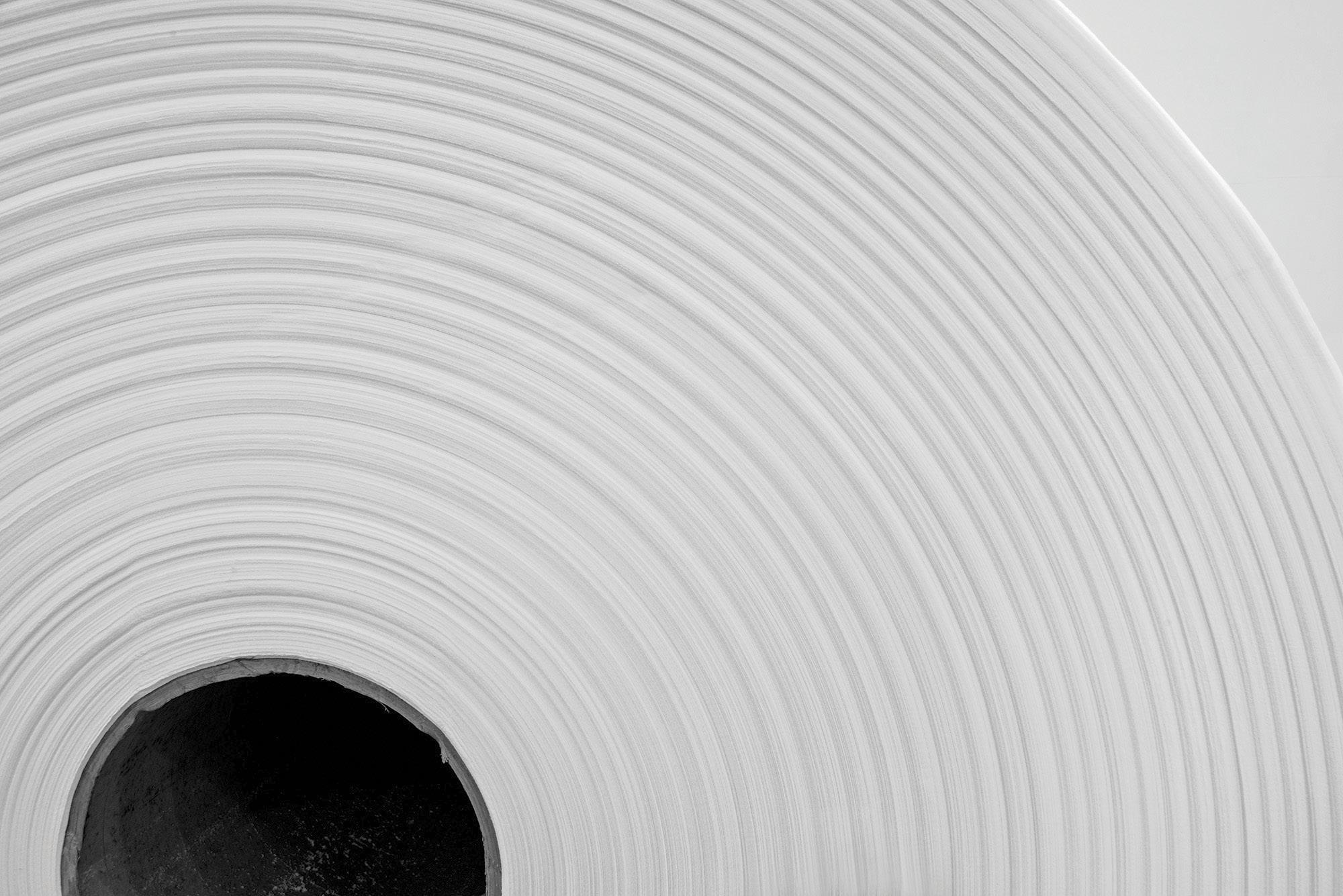
The Abu Dhabi-based team decided to optimise the tissue machine’s performance to increase capacity and boost volume.
In June 2022, it was running at 2,000m/min, and then two months later, it was operating at 2,100m/ min before gearing up to 2,200m/min.
To achieve this, FHH said the running conditions “needed to be perfect, with optimised process settings, chemistry, raw material and production planning.”
The application of autonomous and preventive maintenance programmes, continuous improvements, and corrective maintenance were also essential.
Samir Masoud, UAE Supply Chain and Operation Director, FHH, said: “April 2023 saw a historic moment when we achieved the world record speed of 2,222m/min for 24 hours.

“This great achievement was reached while the machine was producing 13.2 gsm facial tissue at 96.5% efficiency. It is just amazing!
“We have also lowered the machine’s carbon footprint in compliance with our sustainability goals.”
Viktor Bergström, DCT Concept Manager, Valmet, added: “Valmet has done a thorough review of all data to verify that Fine has operated according to tough criteria in order for us to confirm the world record.”
FHH also said it was the first paper mill to sign the United Nations Global compact for sustainability, adopting best practices to conserve resources –water reservation, water treatment, waste recycling, replacing heavy fuels and reducing CO2 emissions.
Abdelhadi Alhader, Project Manager, FFH, said: “Of course it was a challenge to ensure a low environmental footprint while increasing the speed.
8 | July/Aug www.tissueworldmagazine.com
Tissue World Magazine | News in Brief
World record-breaking: The Abu Dhabi-based start-up team in front of the Valmet-supplied DCT tissue machine


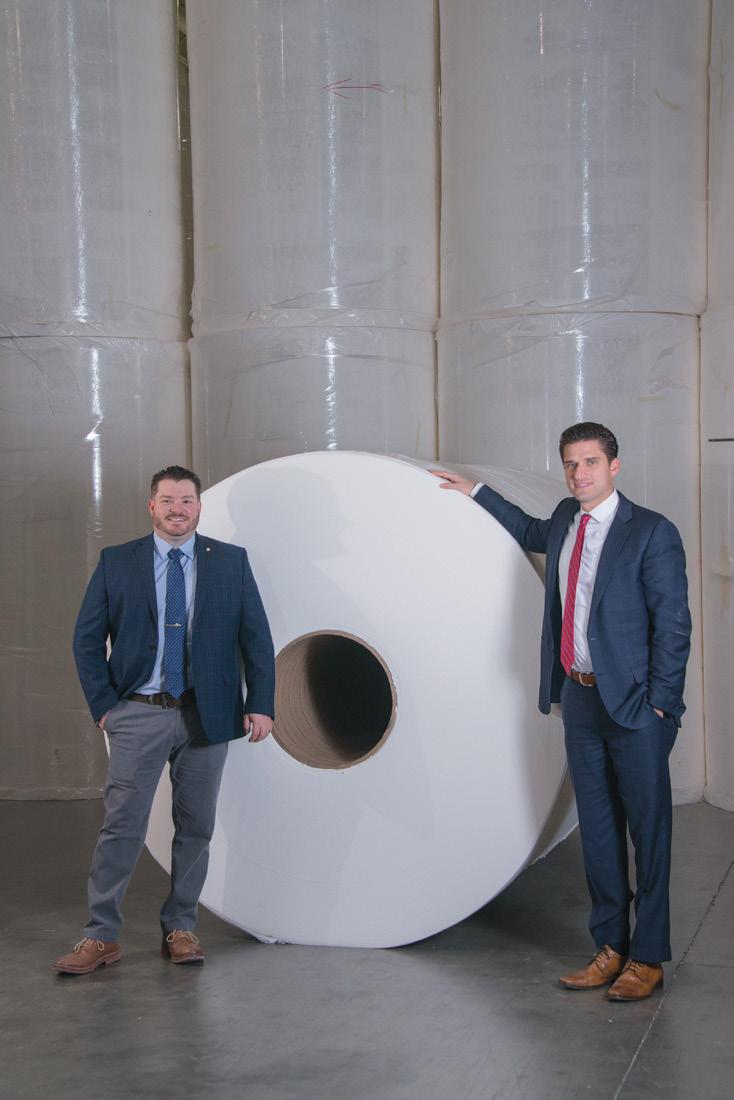
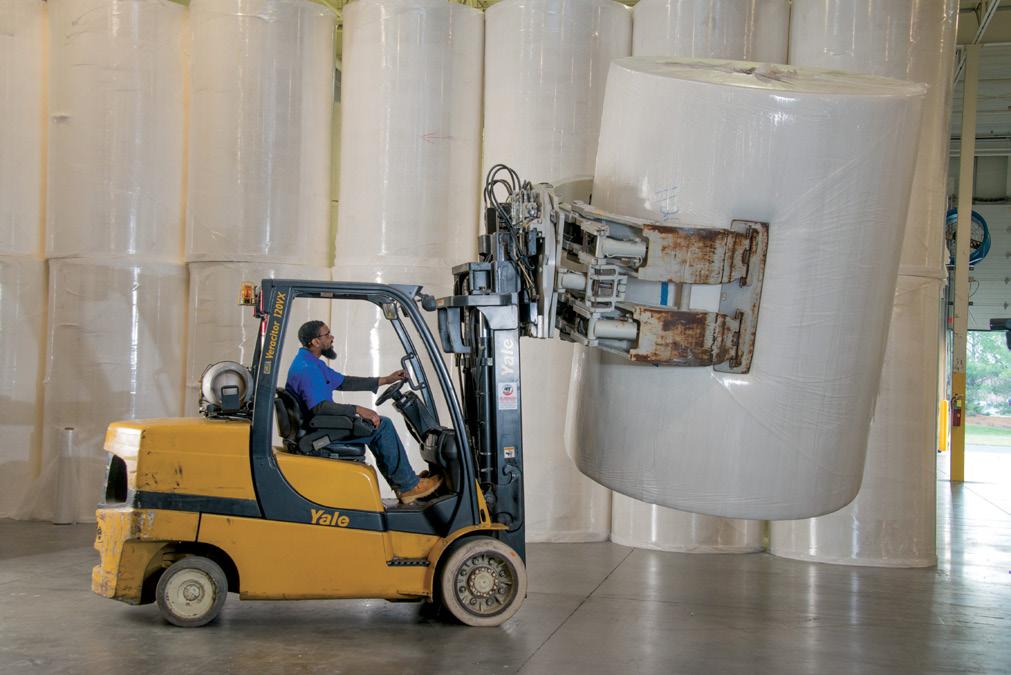


“This huge accomplishment was coupled with great savings. While reducing energy and water consumption, we also lowered the carbon footprint in compliance with the sustainability goals to pass on a healthy environment to the next generation.”
Elia Nuqul established Fine Hygienic Holding in Jordan in 1952. Today, the company operate 10 tissue paper factories in Jordan, Egypt, Saudi Arabia and the UAE.
Global VALMET TO ACQUIRE KÖRBER’S BUSINESS AREA TISSUE FOR €380M
Valmet is to enter the converting and packaging technologies business after announcing plans to acquire Körber Group’s Business Area Tissue.
The Finnish-headquartered company said the move will create the markets’ “widest technology, automation and services offering for the growing tissue industry covering the entire tissue value chain.”
The value of the acquisition is €380m on a cash and debt free basis subject to ordinary post-closing adjustments.
The purchase is estimated to be completed at the earliest on 2 November 2023 and is subject to competition authority approval.
Pasi Laine, President and Chief Executive of Valmet, said: “Valmet benefits from the growing demand for bio-based products globally. With this acquisition, Valmet takes again a new step forward and strengthens both its Process Technologies and Services segments.
“The combination of Valmet’s current tissue making technologies, services and automation offering and the acquired tissue converting offering and competences is a good strategic fit complementing each other and forms a strong basis to create new business opportunities and serve our customers even better.”
Valmet estimates that the acquisition will bring sales, service, and cost synergies worth €8m by the end of 2026.
The acquired business will be integrated into Valmet’s Paper business line as a separate business unit.
Körber will also remain a partner of Valmet and the tissue market through offerings of its other Business Areas, such as its palletising solutions from Business Area Supply Chain.
Körber’s Business Area Tissue offers process technologies and related services for converting the jumbo reels of tissue paper into final tissue products for consumers and the AfH segment.
In 2022, the Business Area Tissue’s net sales were €305m and its adjusted EBITDA margin was 12%.
The business employs around 1,170 employees in Italy, Brazil, the US, China, and Japan.
Stephan Seifert, Chief Executive of Hamburgheadquartered Körber Group, said: “Today our Business Area Tissue is a global market player. Now, joining Valmet, this is an excellent opportunity to form a unique tissue player and set the course for the future.
“The complementary positioning as well as the shared entrepreneurial mind-set and clear customer focus contribute to the best conditions for a successful joint growth trajectory.
“Our Business Area Tissue will be able to further expand its potential, offering, and reach with Valmet as its new committed owner, who will accelerate our efforts to date.
“At the same time, Körber continues and stays fully dedicated to strengthen its other Business Areas and pursue its organic and inorganic growth strategy.”
Oswaldo Cruz, Chief Executive of Körber’s Business Area Tissue, headquartered in Lucca, Italy, added: “Valmet has profound market expertise, a strong customer focus, and extensive experience in integrating additional competencies.
“We are very pleased that in Valmet we have found an ideal future partner for our employees, customers, and suppliers to leverage the full potential of our tissue business.”
Valmet has over 220 years of industrial history and 17,500 professionals providing process technologies, automation, and services for the pulp, energy, and paper industries to customers worldwide.
10 | July/Aug www.tissueworldmagazine.com
Tissue World Magazine | News in Brief
Valmet estimates that the acquisition will bring sales, service, and cost synergies worth €8m by the end of 2026.
ESSITY REPORTS 20.2% NET SALES INCREASE; ANNOUNCES CLOSURE OF TWO NEW YORK STATE PLANTS
Essity has reported continued high sales growth and higher margins in its half-year report, as it fully exits the Russian market and announces restructuring plans in New York state.
Net sales increased 20.2% to SEK86,856m yearon-year, and sales growth – including organic sales growth and acquisitions – amounted to 12.8%.
Operating profit before EBITA increased 101% to SEK 8,660m, while profit for the period increased 139% to SEK5,254m.
In its Consumer Goods division, net sales for the half-year period increased 19.8% to SEK52,653m.
Sales growth, including organic sales growth and acquisitions, amounted to 12.6%.
The company said volumes declined on account of its “prioritisation of higher profitability ahead of volume.”
Additionally, volumes were negatively impacted by lower volumes in Russia.
In the second quarter, the division reported a yearon-year net sales increase of 14.7% to SEK 26,344m.
In Consumer Tissue, organic sales growth amounted to 4.8% in the quarter, mainly because of higher prices in addition to a better mix.
For the Consumer Tissue Private Label Europe division, organic sales growth amounted to 3.5% because of higher prices and lower volumes.
Magnus Groth, Essity President and Chief Executive, said the company “performed well” in the second quarter.
“During the second quarter, net sales increased 15.8% and sales growth, including organic sales growth and acquisitions, amounted to 8.7%.
“Sales prices were higher, and the product mix was better. The lower volumes are mainly the result of our focus on margin improvement, resulting in us exiting certain volumes with unsatisfactory profitability.
“Adjusted EBITA increased by 49% and the adjusted EBITA margin by 2.4% points to 10.7%. The margin was positively impacted by higher selling prices, a better mix and cost savings.”
Groth added the business is progressing towards its return target: “We are working in a focused manner – through innovation, value-generating customer offerings, strong brands, efficiency improvements and sustainable, profitable growth – to achieve our target of an adjusted return on capital employed of above 17% by 2025.”
ESSITY HAS EXITED THE RUSSIAN MARKET
Essity began work in April 2022 to exit Russia, and as of 17 July 2023 has now “completely exited the Russian market”.
It has divested its operations for a purchase price of SEK1.2bn on a cash and debt-free basis.
The buyer is the company New Technologies, with the principal owner Igor Shilov.
Groth said: “Since the start of Russia’s war against Ukraine, we have been fully focused on exiting Russia. This has now been completed.”
In 2022, Essity’s net sales in Russia corresponded to about 2% of its total consolidated net sales.
STRATEGIC REVIEW OF VINDA AND THE CONSUMER TISSUE PRIVATE LABEL EUROPE BUSINESS
On 26 April 2023, the company also initiated an ongoing strategic review of its ownership in Asian hygiene company Vinda and Consumer Tissue Private Label Europe, with the aim of reducing Consumer Tissue’s share of the company’s total sales.
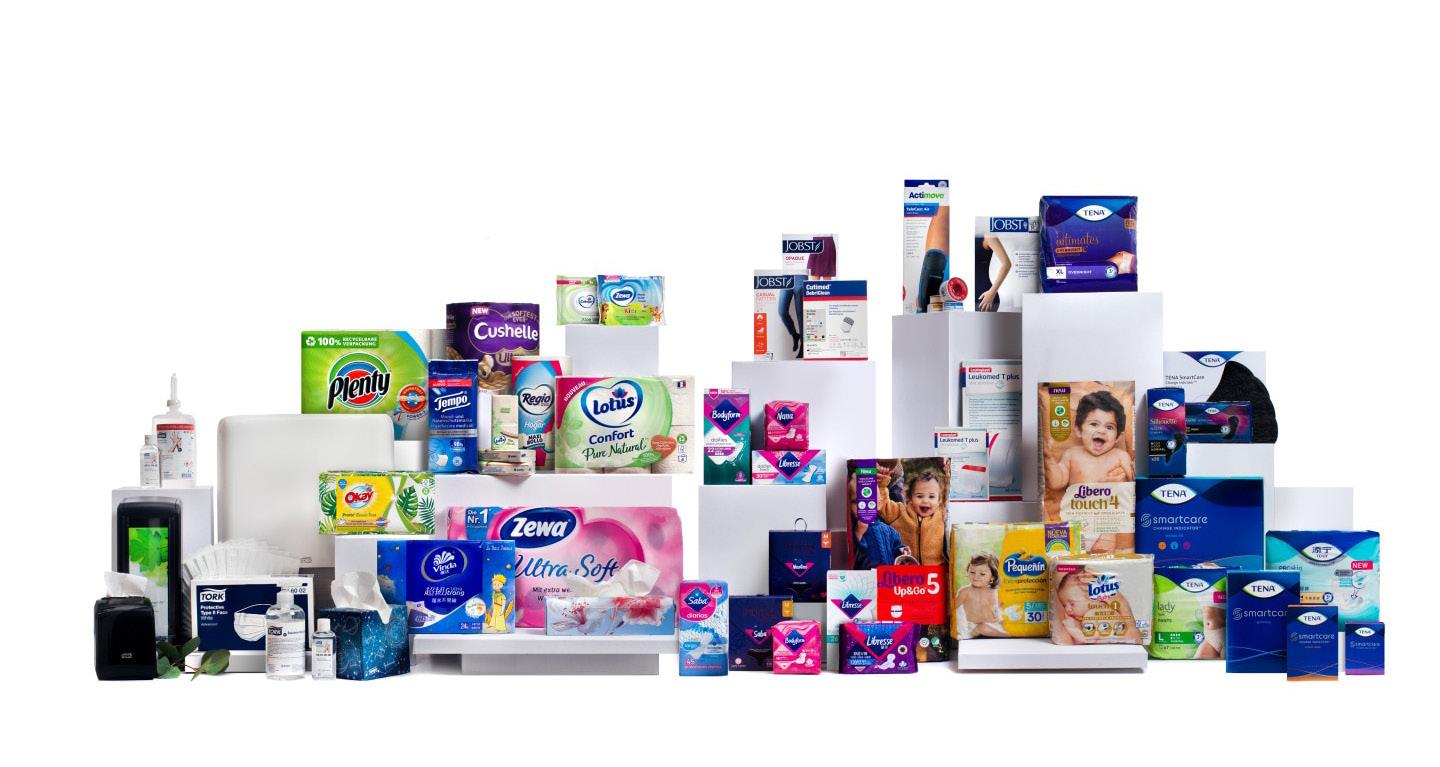
Groth said the review is “proceeding according to plan, and various options are being explored that may result in divestments, although no such decisions have yet been taken.”
Excluding these businesses, he added that
July/Aug | 11 www.tissueworldmagazine.com
Tissue World Magazine | News in Brief
Continued high sales growth: Essity reports a 20.2% net sales increase in its half-year results
the company’s organic sales growth would have amounted to 8.0% and the adjusted EBITA margin to 12.5% during the second quarter of 2023.
ESSITY TO CLOSE MANUFACTURING OPERATIONS IN NEW YORK STATE
The company has announced it will implement restructuring measures in its North American Professional Hygiene division that include the closure of two production plants in New York state.
Its paper mill in South Glens Falls has now been closed, while its converting facility in Greenwich and its warehouse and distribution centre in Saratoga Springs will remain open likely through the end of the year to ensure a smooth transition for customers.
Restructuring costs are estimated to amount to approximately SEK1.2bn, and Essity said the restructuring measures are expected to have a low single-digit negative impact on volume in the second half of 2023 and full-year 2024.
The company said: “Essity is continuing to improve profitability by focusing production and sales on the company’s more innovative and value-creating customer offerings.”
K-C RAISES 2023 OUTLOOK FOLLOWING Q2 RESULTS
Kimberly-Clark Corporation (K-C) has said its Revenue Growth Management programme and productivity have driven “continued margin recovery” in its second quarter results.
The company reported net sales of $5.1bn, up 1%, with organic sales growth of 5%.
Gross margin was 33.7%, up 350 basis points; adjusted gross margin was 34.0%, up 380 basis points versus the prior year.
It has raised its 2023 outlook for organic growth to 3% – 5%, and for adjusted earnings per share growth of 10% – 14%.
On 24 October 2022, Brazilian paper and pulp producer Suzano announced it had acquired K-C’s tissue business in Brazil for $175m.
In June 2023, K-C confirmed it had completed the sale of its Brazilian tissue assets.
Chairman and Chief Executive Mike Hsu said: “We delivered another quarter of strong organic sales growth and gross margin expansion.
“Our growth strategy is working, and given the strength of our first-half results, we’re raising our full-year outlook.
“Continued improvement in gross margin positions us well to invest in superior brand value propositions, including innovation and digital leadership, which will help grow our market shares over time and deliver balanced and sustainable growth for long-term shareholder value.”
In North America, organic sales increased
6% year-on-year, including increases of 1% in Personal Care, 7% in Consumer Tissue and 17% in K-C Professional.
Outside North America, organic sales were up 6% in developing and emerging markets and 4% in developed markets (Australia, South Korea and Western/Central Europe).
Second-quarter operating profit was $113m compared to $621m last year, resulting in an operating margin of 2.2%.
For the first six months of the year, sales of $10.3bn increased 2%, with organic sales up 5%, driven by a 10% increase in price and favourable product mix from ongoing revenue growth management programs offset by a 4% decrease in volume.
Year-to-date operating profit was $900m in 2023 and $1.3bn in 2022.
In its Consumer Tissue Segment, sales of $1.5bn increased 1%, including organic growth of 4%, with gains from price partially offset by volume.
Organic growth of 7% in North America led the increase, with gains in both price and volume.
The company said successful revenue growth management and improving service levels contributed to top-line growth.
Second-quarter operating profit for the division increased 12% to $200m, with organic growth and cost savings partially offset by input-cost inflation, higher other manufacturing costs and higher marketing, research and general expenses.
12 | July/Aug www.tissueworldmagazine.com
Tissue World Magazine | News in Brief
Restructuring costs are estimated to amount to approximately SEK1.2bn, and Essity said the restructuring measures are expected to have a low single-digit negative impact on volume.
SOLENIS COMPLETES ACQUISITION OF DIVERSEY FOR $4.6BN
Solenis has extended its ‘one-stop shop’ offering after acquiring Diversey Holdings in an all-cash transaction valued at an enterprise value of $4.6bn.
Diversey is a provider of hygiene, infection prevention and cleaning products and technology used in food and beverage, institutional, life science and other markets.
With this acquisition Solenis said it is focused on delivering “sustainable solutions for its waterintensive industries and other consumer, industrial, institutional, food and beverage, and pool and spa water markets.”
ABB TARGETS PULP AND PAPER MARKETS WITH LATEST ASM INNOVATION
ABB has launched its latest Automation Software Maintenance (ASM) lifecycle management programme to cover the software related to Paper Machine Drives (PMC800) and Pulp and Paper Process Control Library (PPLib800xA).
The company said the new service is an extension of ABB’s ASM programme and complements the Quality Control System (QCS) ASM programme which was introduced in January 2023.
It added that the aim of the ASM programmes is to offer a tiered subscription service that enables system evolution from older versions to the latest and/or provide on-demand access to regular software updates that include incremental improvements, patches and new features.
ABB said the system “helps pulp, paper, packaging and tissue mills to maximise their
system investment, reduce maintenance, and support costs.”
ASM tiered subscription options open the features available as mills go through the upgrade process.
Shankar Singh, Global Product Line Manager, Drives and Automation, Pulp and Paper, ABB, said: “ABB’s ASM lifecycle management programme has been expanded to offer proactive mill operators even better support for their pulp and paper-specific software, allowing them to better manage and predict total cost of ownership.
“Customers can unlock new features for improved troubleshooting and advanced performance, while at the same time keeping their system software up to date.”
Romania
PEHART GROUP TO BOOST PRODUCTION WITH TM INVESTMENT
Tissue producer Pehart Group is to boost its production capacity after signing up A.Celli to rebuild a tissue machine at its Dej-based facility. The tissue machine rebuilding intervention includes the supply of a reinforced shell, 15’’ forged Yankee Dryer and a last generation Shoe Press specifically designed by A.Celli for tissue paper production.
The machinery supplier said the Shoe Press has been specifically designed “to increase energy efficiency and productivity and enhance paper properties.”
Gabriel Stanciu, General Manager of Pehart Group, said: “Our strategy focuses on the energy efficiency of production equipment and sustainable development, as we have decided to increase our efforts to optimise production machinery.
“The new solutions that A.Celli will provide for this rebuilding will meet our expectations and will serve our purpose to develop production capacity and deliver high-quality products.”
With an almost 186-year tradition, Pehart Group is one of the largest tissue paper producers in Southeast Europe and the largest producer and processor of household paper products in Romania.
UK
ESSITY UK SECURES FUNDING FOR HYDROGEN POWER PLANT TRIAL
Essity UK has secured £2.2m from the UK government to trial the use of hydrogen power instead of natural gas at its paper manufacturing plant in Tawd plant, north-west England.
The Swedish-headquartered company will receive
July/Aug | 13 www.tissueworldmagazine.com
Tissue World Magazine | News in Brief
ABB said the new service is an extension of ABB’s ASM programme and complements the Quality Control System (QCS) ASM programme which was introduced in January 2023.
the funding through Phase 2 of the UK government’s £55m Industrial Fuel Switching Programme.
It will help determine hydrogen’s feasibility as an alternative fuel source for the UK paper-making industry.
The trial will start in 2024 and will involve the existing tissue paper machine, which will switch to hydrogen power to cut down on CO2 emissions.
Essity said the move could potentially lower its CO2 paper manufacturing emissions by 66% and would make the Tawd site the first paper mill in the UK to use hydrogen for this purpose.
The trail for the Industrial Fuel Switching Programme will include:
• Switching the use of heat derived from natural gas, and its associated carbon emissions, with hydrogen
• Hydrogen can deliver large quantities of highgrade heat, offering the potential to replace natural gas without fundamental process changes
• Hydrogen also has the key benefit of being a low carbon fuel, with potential to dramatically reduce the emissions associated with Essity’s operations
• The project, led by Essity and in partnership with Progressive Energy, will address evidence gaps identified during a Phase 1 project by demonstrating the use of hydrogen in paper manufacture at Essity Tawd in Skelmersdale, on live manufacturing equipment.
The UK trial will determine if hydrogen power can be safely and efficiently used as an alternative fuel to produce tissue and towel products.
If successful, the technology could be adopted at Tawd Mill on a permanent basis, as well as being rolled out at other Essity facilities in the UK.
In 2021, the company also launched a €4m pilot project to run a paper machine CO2-free with green hydrogen at its plant in Mainz-Kostheim, Germany.
In March 2023, Essity said it was the first company in the industry to produce tissue in a CO2 emissionfree production process using renewable hydrogen at the Mainz-Kostheim plant.
NORTHWOOD CONSUMA TISSUE TO BOOST CONVERTING PRODUCTION BY 55,000TPY
The UK’s Northwood Group has expanded its converting capability following the launch of its Northwood Consuma Tissue (NCT) division in December 2022 and purchased a 14-acre site housing a 235,000sq ft facility in Ellesmere Port, Cheshire.
A high-speed, state-of-the-art, and fully automated converting line will also be commissioned and operational during Q3 2023.
Phased installation of a further three converting lines will give the site a total finished roll product output of more than 55,000tpy.
The company said the move will “dramatically increase its available output of toilet tissue and kitchen towel and allows it to be true cross-category paper partners to its premium grocery customers.”
In addition to its toilet tissue and kitchen towel output, NCT in Grantham will retain its innovations in facial, toilet tissue and kitchen towel, with specialist print, lotion, and fragrance for events and seasons.
The business added: “As the largest private label facial tissues supplier in the UK, the Grantham site will remain NCT head office and a centre of excellence for the production of facial tissue.
“This site will benefit from further investment as we automate our downstream production lines.”
Northwood Group has planning approval at the Disley tissue mill where plans are in place to expand its paper-making facilities with the installation of a new 100% virgin paper machine with an output capacity of 70,000tpy.
This is additional to the existing four paper mills which manufacture some 100,000mt of paper made from 100% recycled fibre across the UK and Spain.
Northwood Group said the investments “will cement the company as a fully vertically integrated supplier to both the retail and AfH sectors.”
SAINSBURY’S CUTS OWN-BRAND TOILET PAPER PRICES
British supermarket Sainsbury’s is cutting the price of its own-brand toilet paper, a result of the cost-ofliving crisis and the falling cost of pulp.
The retailer said prices would drop by up to 11% as it passed on savings from the falling cost of pulp, which it said had dropped for the first time in two years.
Rhian Bartlett, Food Commercial Director at Sainsbury’s, said: “The rate of grocery price inflation remains at a record high, which is why we are continuing to lower prices wherever we can on the food and household products our customers buy most often.”
Globally, the price of pulp has been falling due to weaker demand, a decline which Bartlett said means the company can pass on savings directly to consumers.
“After more than two years of inflation on the price of pulp, we are now seeing a decline which is enabling us to pass savings directly on to our customers and reduce the price of our own brand toilet roll.
“From today, our by Sainsbury’s Super Soft double toilet rolls have been added to our popular Aldi Price Match campaign for the first time, and customers will now be able to save as much as 11% on these items.
14 | July/Aug www.tissueworldmagazine.com
Tissue World Magazine | News in Brief

“In addition to food, we’re focused on battling inflation on high volume household products that we know customers buy day in day out.”
Products that will drop in price include:
• by Sainsbury’s Super Soft White Toilet Tissue
Double Rolls 2 equals 4, was £1.90 now £1.69;
• by Sainsbury’s Super Soft White Toilet Tissue
Double Rolls 4 equals 8, was £3.25 now £2.92.
Last month the company announced it was combining its own-label value ranges into one brand, Stamford Street, to help customers more easily find everyday staples at budget-friendly prices. The range features over 200 products, 10% of which are new.
South Korea
MIRAE PAPER BOOSTS CAPACITY WITH TM START-UP
Mirae Paper has boosted its production capacity after starting up a Toscotec-supplied TT SYD Steel Yankee Dryer.
Mirae Paper started up the line to replace an existing Cast Iron Yankee on PM2 at its Jeonju mill.
It is the company’s second TT SYD installation following another Yankee replacement by Toscotec on PM3 in 2013.
Yeong Rok Lee, Mirae Paper’s Production Manager, said: “This new Yankee on PM2 has been performing very efficiently for over two months now.”
Toscotec said that its latest generation of TT SYD installed on Mirae Paper’s PM2 “benefits from an ideal ratio of the height, width, and distance between the Yankee’s internal ribs and the optimization of its shell thickness.”
It said: “This design guarantees the highest possible thermal energy transfer efficiency at the drying heart of the tissue machine.”
Established in 2000, Mirae Paper operates one paper mill in Jeonju, South Korea, where it manufactures up to 65,000tpy of high-quality tissue including toilet tissue, handkerchiefs, and towels, using both virgin and recycled fibres. It distributes its products mainly to the Korean market.
Canada CANFOR PULP’S NORTHWOOD MILL RESUMES OPERATIONS
Canfor Pulp Products has confirmed operations at its Northwood Pulp Mill in Prince George have resumed following labour disputes at the British Columbia ports.
A spokeswoman for the company confirmed to TWM production at the NBSK-producing plant had started again in the week beginning 17 July, following a tentative agreement in the labour dispute.
On 13 July, Canfor temporarily curtailed production in Prince George. It said the curtailment was due to limited storage space for pulp products that cannot be transported overseas due to the industrial action.
The downtime removed around 11,000 tonnes of market kraft pulp per week.
Poland
VELVET CARE CUTS CO2 EMISSIONS WHILST QUADRUPLING CAPACITY IN A DECADE
Polish consumer tissue manufacturer Velvet Care has said it reduced its CO2 emissions and water usage per tonne of output by half since 2013, whilst quadrupling its tissue production.
The company published its first report on environmental, social and governance (ESG) initiatives with reference to the Global Reporting Initiative (GRI) Standard, showing 2022 CO2 emissions of 0.347 eMgCO2 (tonnes of carbon dioxide equivalent per tonne of tissue produced), and water usage of 6.22 cubic metres per tonne.
The document comes three years before the deadline to begin ESG reporting under the European Union’s CSRD Directive.
From 2013 to 2022 production of tissue paper rose to 140,000 tonnes from 35,000 tonnes, while CO2 emissions per tonne of output fell 49% and water usage dropped 52%.
Velvet Care Chief Executive Artur Pielak said: “In our five-year environmental strategy, Eco Agenda 2025, we set ourselves the goal of ‘achieving more with less,’ and the entire team is working hard towards this goal.
“We prepared this report with reference to GRI, the internationally recognised reporting standard, to demonstrate that we are living up to our promise.
“We are also putting our values into practice in areas such as care for our employees and ensuring gender diversity in the leadership of our company.”
The company’s factory in Klucze, southern Poland – for which figures were gathered for the report –has three tissue machines.
The group operates a total of 19 converting lines that turn out toilet paper, kitchen towels and hygiene facial tissues.
Velvet Care’s social responsibility efforts also include providing 28,000 rolls of toilet paper and paper towels for the Red Cross to distribute to refugees from the war in neighbouring Ukraine, as well as collecting funds and supporting employees’ volunteer efforts.
16 | July/Aug www.tissueworldmagazine.com
Tissue World Magazine | News in Brief
China
LIANSHENG PULP & PAPER BOOSTS CAPACITY WITH TM START-UP
Liansheng Pulp & Paper (Zhangzhou) has started-up two Andritz-supplied PrimeLineTM tissue machines at its plant in Fujian Province.

The two PrimeLineTM W 2000 lines have a design speed of 2,000m/min and a working width of 5.65m.
Both are equipped with 20ft. PrimeDry Steel Yankees and steam-heated hoods.
The stock preparation systems, using NBKP and LBKP feature FibreSolve FSV pulpers, a pulp screw press and HC refiners to achieve consistencies in the range of 25%-30% and excellent fibre properties.
The scope of supply also includes the approach flow systems, broke handling, and a comprehensive fabrics and rolls package (forming fabrics, press felts, roll covers) for optimum dewatering at high speed.
Fan Lele, Vice Sales General Manager of Household Paper, Liansheng Pulp & Paper, said: “We were really excited to hold the first tissue in our hands. The tissue quality has been excellent right from the start.”
Liansheng Pulp & Paper (Zhangzhou) Co., new production base of the Liansheng Paper Group, was established in 2020 to enter into the household paper production industry.
EUROPE
TORK BRAND OFFERS RANGE OF CARBON NEUTRAL CERTIFIED DISPENSERS
Essity has said its Tork brand is the first in Europe to reduce and compensate carbon emissions for the entire life cycle* of selected soap, toilet paper and hand towel dispensers. It said its Tork brand now offers “carbon neutral certification on a range of its existing dispensers, after achieving a combination of carbon reduction and compensation across the entire life cycle – from raw materials to end-of-life.”
The 27 Tork carbon neutral dispensers are produced with certified renewable electricity, and the remaining emissions are compensated with certified climate projects.
The Tork carbon neutral dispensers are now available in Europe (excluding France).
Essity said it has already reduced the carbon emissions for the 27 Tork dispensers by using certified renewable electricity for the production.
To reach carbon neutral, the company is now compensating the remaining carbon emissions through investments in certified climate projects with ClimatePartner.
It said the selected projects reduce carbon emissions by supplying clean drinking water in Cambodia, providing energy efficient cookstoves in India, and supporting forest protection in Indonesia.
*Excluding use of refills. Valid for dispensers sold after 1 May 2023 in European countries.
July/Aug | 17 www.tissueworldmagazine.com
Tissue World Magazine | News in Brief
Start-up team: TM1 at Liansheng Pulp & Paper (Zhangzhou) Fujian Province tissue plant
IS THE TISSUE CONSUMPTION LEADER ABOUT TO ENTER A NEW MARKET ERA?

Even a two decades long upgrade in machinery – net gain of six installed since 2007 – has seen CAGR drop from 1-2% to 0.83%. The region is being closely studied to see if sustainability plays a more significant part in quality or cost requirements as the dominance of traditional manufacturers declines. Fisher International’s Senior Consultant Bruce Janda reports.
The United States has the world’s largest economy, and the third-largest population. Tissue producers across the whole of the North American region operate in a unique market. It is a very slow-growing and mature market despite Americans consuming tissue at the highest per-person rate in the world.
They also consume more tissue products away from home, such as when traveling, working, or entertaining. Average production for this area comes in at about 35% Commercial or AfH tissue, which again is the highest rate globally. This is why there was such a disruption in the tissue sector during the pandemic when everyone had to stay home.
The United States has the most significant percentage of tissue capacity running with TAD or other structured technology for advanced tissue production. After all, the birthplace of TAD technology was in Green Bay, Wisconsin.
However, Canada and Mexico play significant roles in production and consumption due to the North American Free Trade Agreement (NAFTA). Because of this, tissue finished products and parent rolls have
free access to be transported across the continent. Therefore, Mexico and Canada continue investing in domestic TAD or structured tissue technology.
For example, Kimberly-Clark’s minority interest in Kimberly-Clark de Mexico dates back decades. There is also a trend of Canadian investment in US tissue mills, with some interest from Mexican tissue companies. This is because Canadian tissue consumers have very similar consumption rates and product wants. Mexico’s consumers on the other hand have a wide range of purchasing power, but it is still possible to find very high-end tissue products designed for affluent markets in specific locations.
The United States population growth rate is estimated at 0.68% in 2023 by the World Factbook. The population trend and GDP per person are shown in Figure 1. GDP results sagged in 2020 due to the pandemic but recovered smartly in 2021-22. Canada’s income and population trends are very similar, as shown in Figure 2. The country’s population growth is estimated to be 0.73%, and generally slightly greater due to more immigration support.
Mexico’s trends are shown in Figure 3. Their income is about 35-40% of Canada or the United
18 | July/Aug www.tissueworldmagazine.com
Tissue World Magazine | Fisher
Toscotec OPTIMA line.
Top tissue quality and winding efficiency.

increasing the overall production efficiency. Through an innovative combination of center wind assist control of the parent reels, unwinding web tensioning system and rewinding nip control system, OPTIMA rewinders preserve tissue quality and deliver optimal reel uniformity. Top tissue quality meets high winding efficiency.
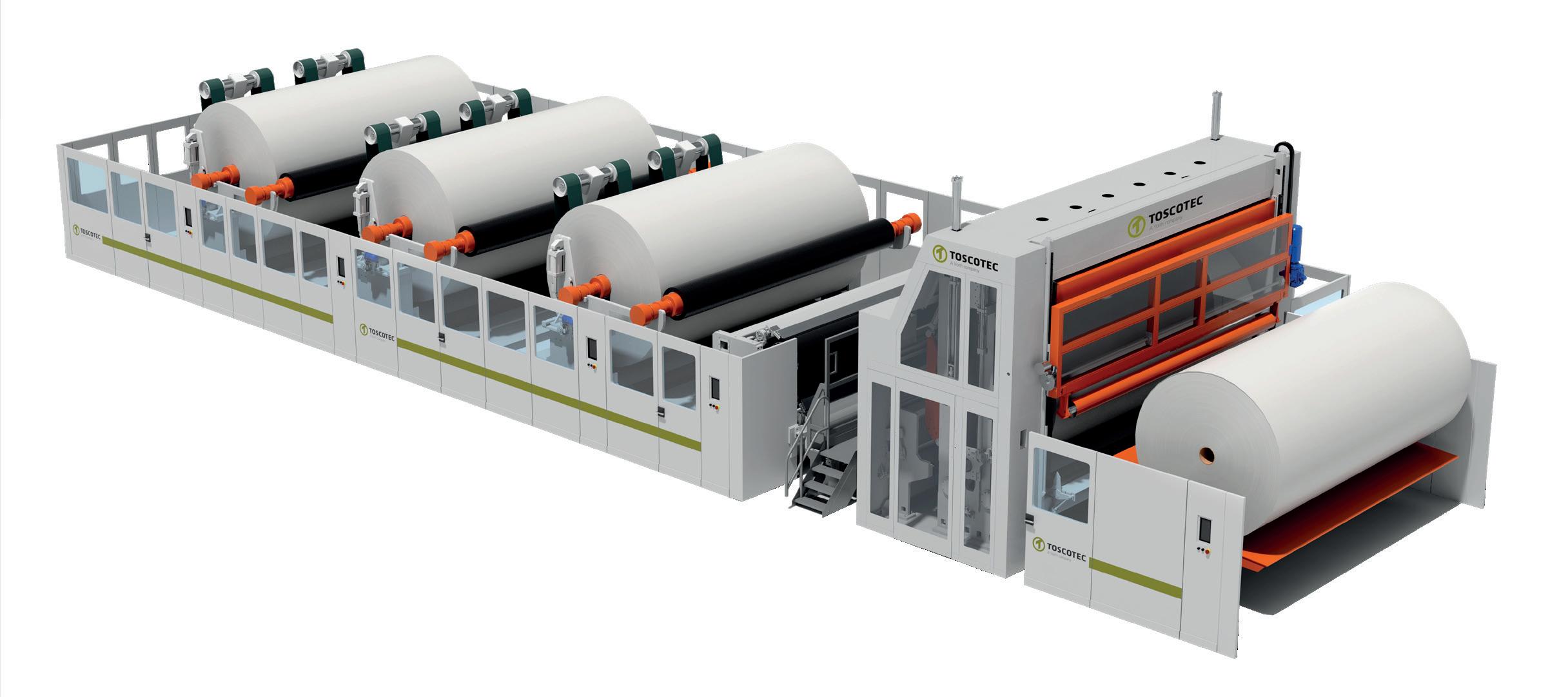
YOUR NEEDS OUR SOLUTIONS www.toscotec.com
States. Although Mexico has the world’s tenthlargest population, it is now growing slowly at about 0.61%.

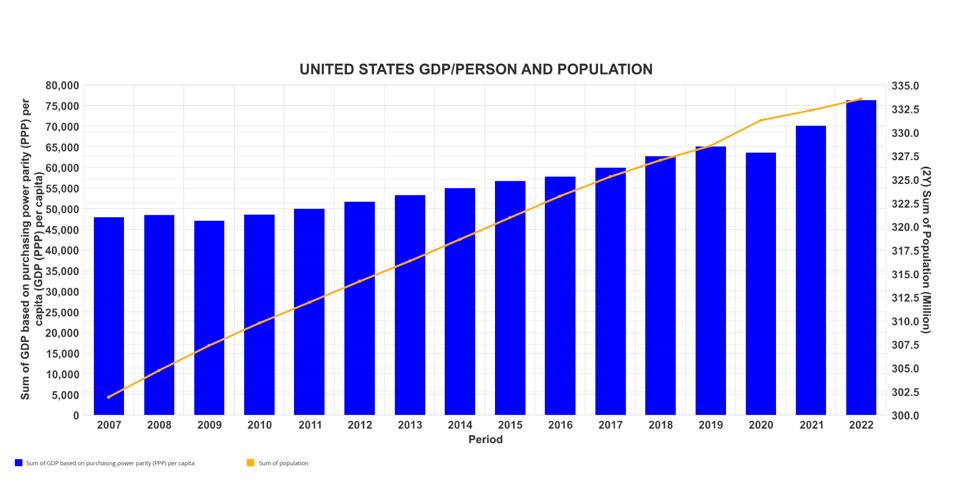
Unemployment and inflation are the other statistics that correlate to tissue demand. Americans enjoyed historically low unemployment and inflation after the Great Recession. However, the global inflation spike in 2022 has hit American consumers hard, as shown in Figure 4.
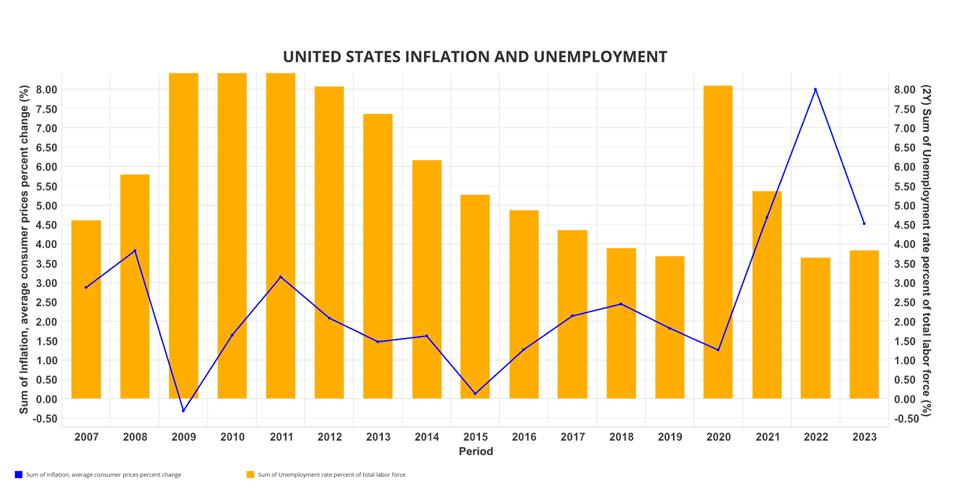
This is due in part to wartime energy price shocks and excess demand or consumption shifts after emerging from the pandemic. Unemployment recovered to pre-pandemic levels and has resisted the Federal Reserve Bank’s efforts to slow business activity. Overall, consumer buying has returned to pre-pandemic behaviour.
Canada’s inflation experience was very similar to the United States, as shown in Figure 5. Canada’s unemployment has been relatively steady and running about 1% higher than the US. Mexico’s economy tends to be less linked than the US and Canada, but the same trends can be seen in Figure 6.

The United States imports about 700,000 tons of tissue yearly, as shown in Figure 7. The leading suppliers in order of input volume are Canada, China, Indonesia, Mexico, Italy, and Turkey. As we can see, there was a surge in imports in 2020, presumably due to the pandemic. This volume represents less than 10% of total US capacity.
The United States exports about 60% of the tissue volume it imports, as shown in Figure 8. Mexico and Canada are the only significant customers for United States tissue exports.
United States tissue producers have been actively removing and replacing old machines with new, significantly more productive assets in the last two decades. Figure 9 shows that a net gain of six new machines were installed since 2007. US tissue capacity grew at a compound annual CAGR of 0.83% over this study. This is much slower than the historical growth rate of 1-2% for this mature market.
In comparison, Canada’s CAGR rate was 0.25% during this. However, new announcements will boost Canada’s production by 3.9% by 2025. Mexico experienced a 3.18% CAGR but does not have new machines planned before 2025.
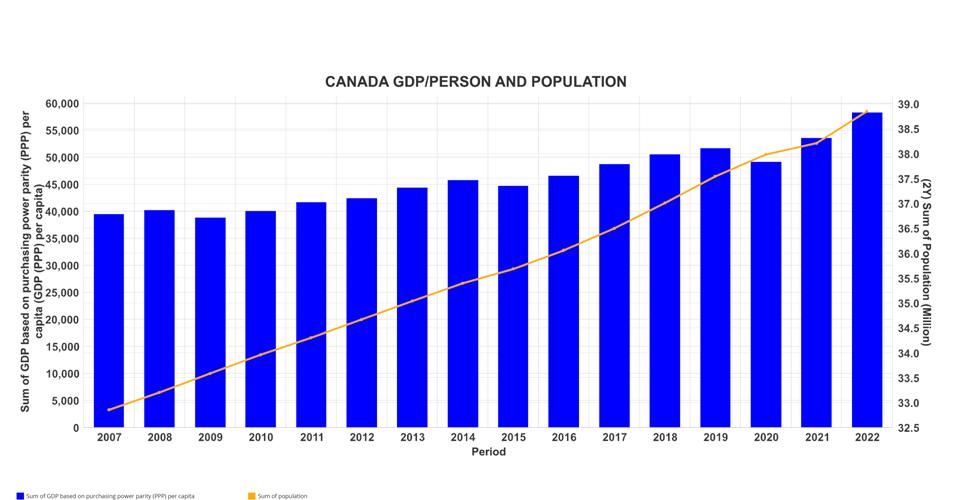
United States tissue producers have the world’s largest advanced process tissue machine fleet using TAD or structured technology. 44% of the total capacity is some form of advanced structured tissue. Figure 10 shows how tissue finished product formats deploy this advanced tissue capacity.
64% of consumer bath tissue is produced using advanced technology. The amount of advanced bath tissue production is due to Americans’ desire for exceptionally soft tissue at low strengths.
20 | July/Aug www.tissueworldmagazine.com
Figure 1: United States GDP/person and population trend
Figure 2: Canada GDP/person and population trend
Figure 3: Mexico GDP/person and population trend
Figure 4: United states unemployment and inflation trend
Tissue World Magazine | Fisher
Figure 5: Canada unemployment and inflation trend
This is a less common factor driving advanced bath tissue production in Europe. The total volume of consumer towels is slightly less than bath tissue production but requires 74% advanced tissue capacity. Americans’ kitchen towel usage per capita is much higher than in Europe. Still, we see the trend in using advanced structured technology to achieve absorbency performance and reduce the total amount of towels required in most markets. The United States’ production includes about 35% commercial tissue, much higher than Canada, Mexico, or European countries. Some of this volume is being exported to Canada and Mexico. There is a new trend toward commercial hand towels employing advanced technology being seen, with 22% of production using structured or TAD processes. While there isn’t an advantage for using advanced tissue technology in napkins, there is just a small one for commercial bath and consumer facial tissue.
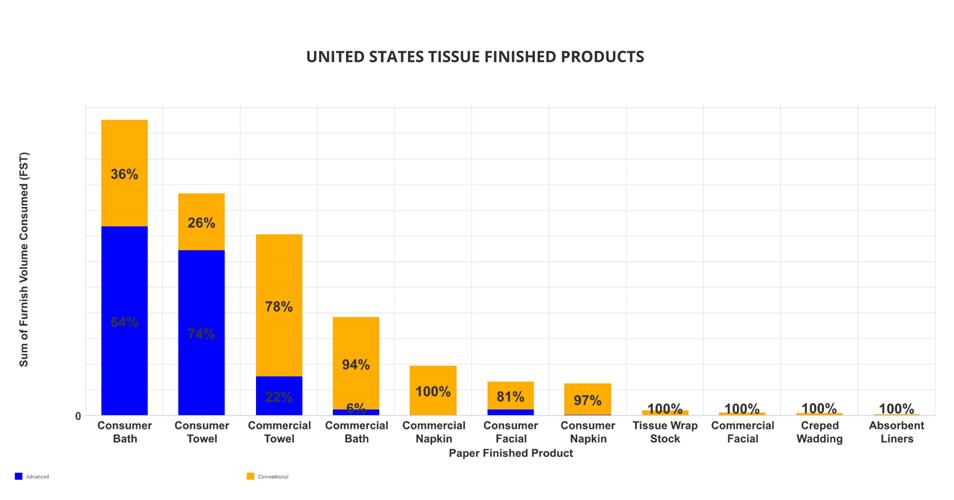
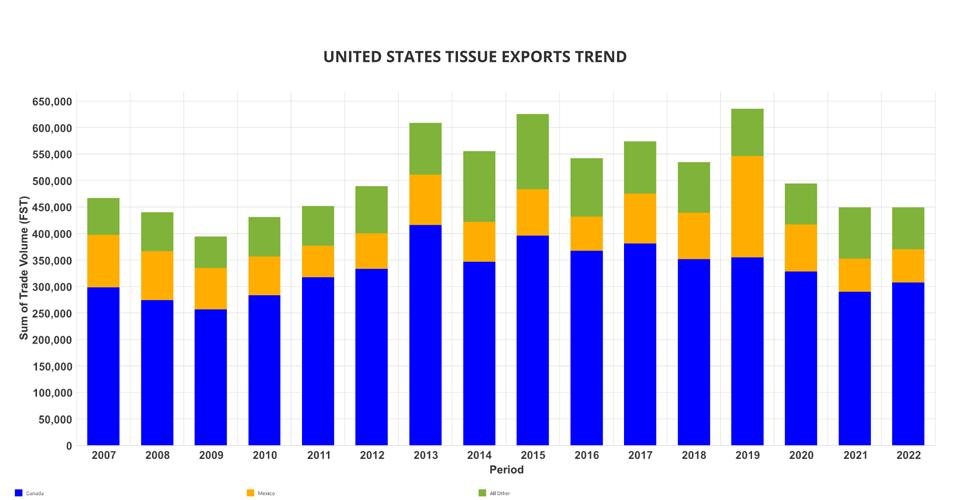
Figure 11 shows the furnish used in the same product categories. Eucalyptus fibre is used in more than half of consumer bath tissue production, with a small amount in consumer towels and a large percentage in consumer facial. Commercial grades tend to use high rates of recycled fibre.
Figure 12 analyses the average tissue machine quality by country for the United States’ main trading partners. The X-axis represents the average technical age of the tissue machine fleets. It reflects when a machine was built and whether it has been updated to deliver current productivity and quality levels. The Y-axis shows the average machine wire width for each country. This is used to get an idea of how much production can be made by each machine.

The bubbles’ size represents each country’s relative total tissue capacity. China has the newest but narrowest fleet of tissue machines; Canada’s are relatively old and somewhat narrow; and US machines are also rather old but are the widest on average in this analysis. Presumably, this size increase has helped them remain competitive. Italy and Mexico have relatively middle-aged machines, but Mexico is significantly wider.
The same competitive set is shown in Figure 13 as a cash cost analysis. As we can see, Indonesia is the lowest cost producer, driven by low pulp costs. China and Mexico have very similar cost levels but for different reasons, as Mexico uses much more low-cost recycled fibre that China doesn’t use in tissue production. Turkey, the United States, and Canada have similar overall cost levels, but Italy suffers from high energy costs.

Analysing average cash costs of tissue production in situations with large amounts of TAD or other structured tissue technology without considering the specific effects on cost and basis weight required for a product can be misleading. Figure 12 repeats the

July/Aug | 21 www.tissueworldmagazine.com
Figure 6: Mexico unemployment and inflation trend
Figure 7: United states tissue imports
Figure 8: United states tissue exports
Figure 9: United states tissue machine count changes
Tissue World Magazine | Fisher
Figure 10: United States finished products by technology
cost analysis using costs per case adjustments that reflect the ability of advanced tissue processes to produce higher product performance with less basis weight than conventional products. This results in a significant shift for the United States due to its large percentage of advanced technology employed. Mexico also sees a similar change.
Figure 15 looks at the average tissue machine viability for each country. The viability analysis includes the costs already discussed. Still, it includes the capital required, the grade risk of each machine, internal company risk, manufacturing competitiveness, the overall size of the machine, technological age, and the tons per unit of width. The United States appears favourably in this analysis, but Canadian machines are showing their age.
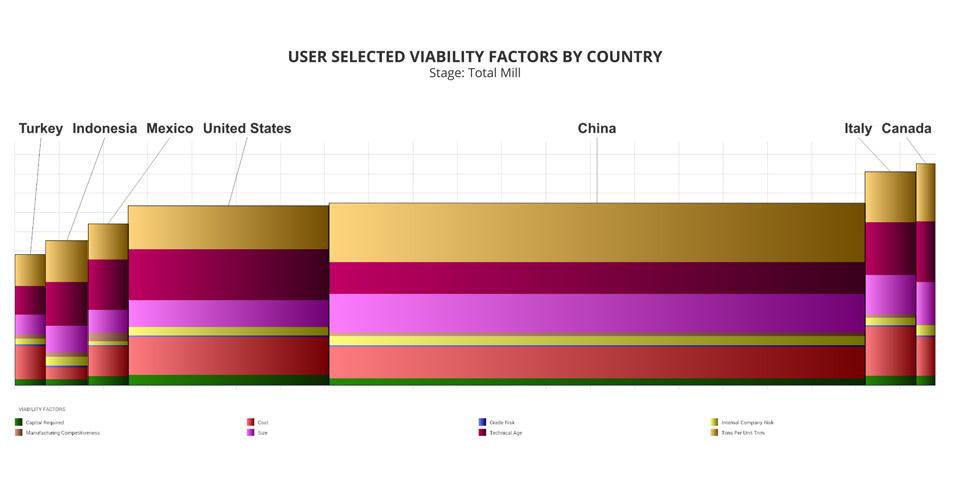

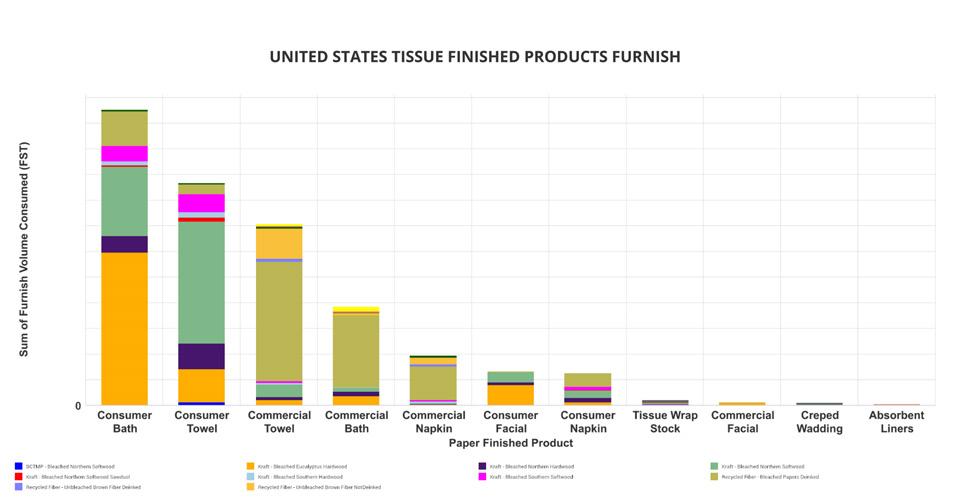
Any analysis of carbon emissions should start with the energy cost required to produce a ton of tissue. Figure 16 shows that Indonesia, China, and Canada have low energy costs. Turkey and the United States are competitive. Canada’s advantage is due to its hydropower. Mexico and Italy are high outliers in this group.


Figure 17 shows the same energy analysis but as energy units required per ton as opposed to the cost of the units. This reverses the results based on energy prices and puts the United States, Canada, and Mexico on the higher end of energy consumption. This is probably due to higher average softness requirements that means using extra drying before creping and a more significant percentage of advanced tissue technology that uses less pressing for water removal. North America enjoys relatively low energy costs making conservation efforts less rewarding on a cost basis.
The carbon emissions per ton chart in Figure 18 shows a cradle-to-gate analysis that includes emissions from raw material production and transport, electric grid costs, and the fuel used on site. Canada leads in this area due to its low electric grid emissions driven by the large percentage of hydropower available. The United States and China are about the same. Carbon emission regulations are at greater risk to the United States as historically low-priced energy has not rewarded efficiency efforts.
The United States tissue business is unique in customer consumption rates, percentage of TAD or other advanced technologies, and the exceptional drive for softness in consumer grades. American consumers tend to use more disposable kitchen towels at home than Europeans, which helps account for the increased consumer towel demand rates.
Canadians also tend to use more towels, which is why they experienced shortages during the pandemic. Mexico and Canada are top trading partners of the United States and have developed
22 | July/Aug www.tissueworldmagazine.com
Figure 11: United States finished products furnish
Figure 12: Na tissue machine quality companies by country
Figure 13: Trade group average cash cost/ton
Figure 14: Trade group average cash cost/case
Tissue World Magazine | Fisher
Figure 15: Trade group average tissue viability
some of these same consumer behaviours. Canada and Mexico do not produce much commercial tissue, which would support the very high production rate in the United States. The march toward more advanced tissue process deployment (mostly TAD) continues in the United States with new capacity installations underway by Georgia Pacific in Wisconsin and Procter and Gamble in Utah.
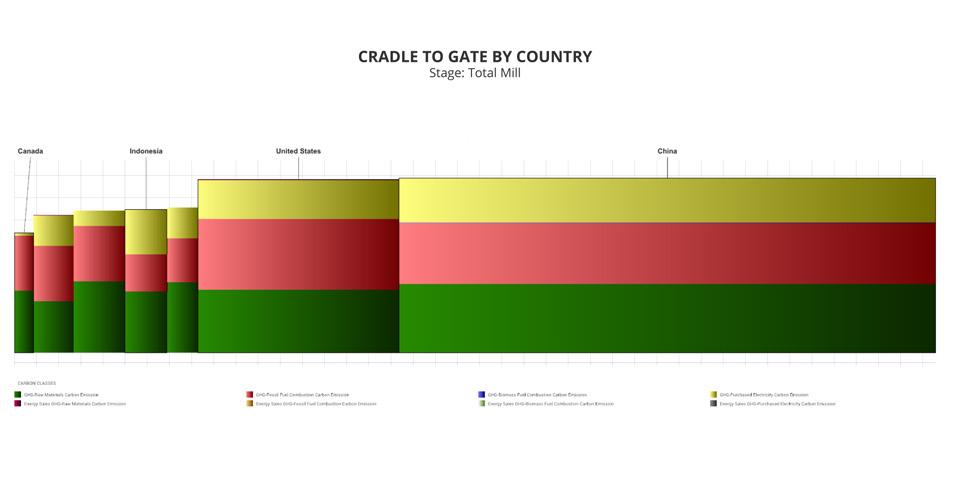
Canada has ended a long drought of no new TAD machines with the newest Kruger machine installation in Quebec. Mexico doesn’t have any new machines announced but has added a significant amount of advanced process machines. There is no sign of an end to deploying advanced process technology in North America to meet highperformance consumer expectations.
The North American tissue market dynamics have attracted many new players, including European Essity and Sofidel and new American companies like First Quality Tissue. The dilution of producers’ market power in the United States compared to historical market concentration will continue to drive consolidation and closures of older assets that can’t meet quality or cost requirements.
Sustainability factors such as carbon emissions, fibre sourcing, and product design can be expected to play a more significant part. American tissue consumers could become more discerning about sustainability and drive winners and losers among the tissue producers. Could the growth of tissue consumption per capita and TAD in the United States finally peak and start to decrease with increased consumer concern about sustainability?
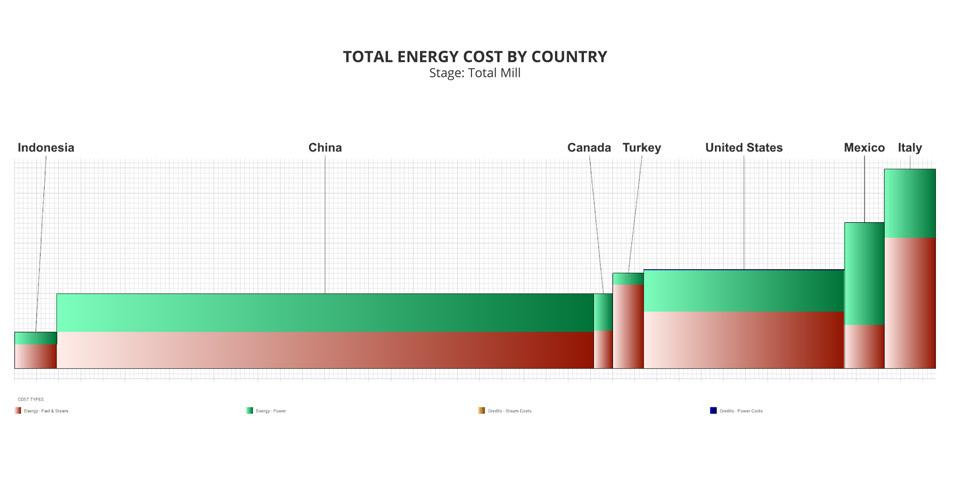
This is an area that producers and investors need to watch closely. All the data presented in this report represent averages of a considerable fleet of tissue producers in the United States. Analysis of competitive position requires specifics on tissue producers and individual machines. This article presents a static picture summary of the North American tissue industry today. Fibre prices, exchange rates and environmental regulations will change, providing some participants with advantages and others with new challenges. US tissue mills will continue to change hands and perhaps consolidate; neighbouring countries may invest in tissuemaking capacity, thus affecting America’s imports and exports.

July/Aug | 23 www.tissueworldmagazine.com
Figure 16: Trade group average energy cost per ton
Figure 17: Trade group average energy units/ton
Canada has ended a long drought of no new TAD machines with the newest Kruger machine installation in Quebec.
Tissue World Magazine | Fisher
Figure 18: Trade group average carbon emission by ton (cradle to gate)
PRODUCERS SHARPEN PORTFOLIO AND MARKETING NARRATIVES AS CONSUMERS ADOPT NEW ‘COPING MECHANISMS’
The uneven post-pandemic recovery continues and essential products dominate, as emerging trends reinforce the urgency needed to reassess supply chain efficiency. Euromonitor International’s Head of Tissue and Hygiene Liying Qian reports.

Despite a broad return of life routines and introduction of hybrid work that have underpinned the sustained growth of retail tissue in 2022 in North America, there remain significant challenges.
These factors include high inflation, rising unit prices and strained supply chains which have cast a tale-of-two-city spell on the category, with current value (including inflation effect) registering a positive single-digit growth, strengthening from a single-digit decline in 2021, while volume and real value sales (excluding inflation) slightly contracting in 2022.
Such diverging growth patterns emerged as consumers coped with higher prices by switching to cheaper brands, buying smaller packages or simply cutting back.
Such coping mechanism are evidenced in their shift towards cheaper options such as private label,
which has also benefitted from retailers’ promotion and support of own brands. In North America, private label has gained market share in retail tissue to reach nearly 28% in 2022, with paper towels and toilet paper seeing the most visible share gain between 2021 and 2022.
Such growth dynamics further reinforce the urgency to reassess supply chain efficiency and to sharpen portfolio and marketing narratives to land the best intersection of value and efficacy for all consumers.
INFLATION POSTS CAUTIONARY NOTE FOR CONSUMER SPENDING AND UPHOLDS EFFICIENCY PRIORITY
Despite certain signs of relief ahead as pulp capacity catches up and supply-demand rebalances, the outlook for retail tissue consumption in 2023 in North America is still cautious based on lower consumer confidence and purchasing power amid
24 | July/Aug www.tissueworldmagazine.com
Tissue World Magazine | Euromonitor
persisting, albeit moderating, inflation pressure and uncertainty.

North American retail tissue industry statistics are predicted for April to show a decline by 1.3% in volume in 2023. This represents a 0.2%-point downgrade against expectations estimated in February 2023.
As such, efficiency upgrade as a way to counter cost pressure and recover margins long-term has become a priority of business investment.
Many leading tissue players in North America have striven for better alignment with longterm consumer demand by investing towards capacity and efficiency with a focus on highmargin, high-quality items.
For example, KP Tissue has shifted manufacturing focus towards higher-efficiency TAD operations that integrate artificial intelligence and higher-margin products such as facial tissues in its Sherbrooke operations, where a facial tissue line is set for implementation in Q4 2023, and Memphis operations, where it has retired less economically viable legacy assets, according to the company. Similarly, Georgia-Pacific has set to grow its own premium tissue brands and private label manufacturing capacity by expanding its Green Bay mill and adding TAD technology and additional converting operations. Strategic M&As such as Paper Excellence’s acquisition of Resolute Forest Products demonstrate a drive for supply chain resilience through diversification.
DEMOGRAPHIC AND LIFESTYLE SHIFTS SUPPORT RETAIL TISSUE OUTLOOK
Longer term, retail tissue’s forecast growth will continue to build on consumers’ life habits and routines.
According to Euromonitor International’s Forecast Model, which examines various forecast drivers, fundamentals like population growth will remain key positive drivers of retail tissue’s forecast growth. For example, between 2022
July/Aug | 25 www.tissueworldmagazine.com
-15% -10% -5% 0% 5% 10% 15% 20% 25% 2017 2018 2019 2020 2021 2022 2023 2024 2025 2026 2027 Retail Volume, 000 Tonnes Retail Value RSP (USD million, current) Retail Value RSP (USD million, constant) Historic Forecast North America Retail Tissue: 2017-2027, in Retail Value RSP (USD mn) and Retail Volume ('000 Tonnes) Terms Year-on-Year % Growth
Tissue World Magazine | Euromonitor
Product pricing remains a negative contributor to retail tissue’s forecast growth, particularly in facial tissues and paper tableware where it forecasts an approximately -1% impact on 2022-2027 constant value CAGR
Source: Euromonitor International, Tissue and Hygiene research, updated in February 2023
and 2027, the total population in North America is projected to expand by about 3%. However, product pricing remains a negative contributor to retail tissue’s forecast growth, particularly in facial tissues and paper tableware where it forecasts an approximately -1% impact on 2022-2027 constant value CAGR.
Therefore, tissue players that have raised prices since January 2021 should not only be attentive to consumers’ price sensitivity to avoid trading down to cheaper brands, but, more importantly, fully leverage pricing and supply chain strategy in an anticipated recovery in consumption and quality expectation as consumers regain financial confidence and further adapt to new life routines in the longer term.
Take toilet paper, the largest retail tissue category. As a considerable and growing number of consumers, especially younger age groups, are choosing lifestyle options that allow for more flexibility, demand and expectation for daily essentials such as toilet paper will grow, encouraging new product features from pack size to functionality, aesthetics and fragrance that better fit and enhance new life occasions from work to dining. Indeed, in 2023, 36% and 31% of consumers in Canada and the US, respectively, expect to work from home in the future, up from 29% and 29% in 2019, according to Euromonitor’s Voice of the Consumer Lifestyles survey fielded early each year.
STRONG VALUE FOCUS AND LIFESTYLE TRANSFORMATION CATALYSE MULTI-FACETED TANGIBLE VALUE STRATEGIES
While inflation is one reason for price increases, as confirmed by nearly two thirds of retail tissue
industry professionals surveyed by Euromonitor in December 2022, it can also be a stimulant for value creation.
However, amid a backdrop of inflation, consumer pricing sensitivity, simplified routines, and evolving lifestyles such as flexible working and heightened health awareness, the path to value creation in retail tissue is multifaceted and nuanced across product types.
For tissue products with strongest usage frequency and most direct health implications, such as toilet paper, brands have enhanced branding around performance-based, comfort-centred value add, with a focus on absorbency and softness. This move is demonstrated in Kimberly-Clark’s rebranding for Cottonelle Ultra Comfort and Ultra Clean toilet paper, which features CleaningRipples texture to remove residue and absorb more moisture and is further promoted in the DownThereCare campaign tabooed down-there issues such as skin sensitivity and humidity. Meanwhile, fragrance, still quite a niche feature, is increasingly encompassed in tissue to create a heightened sense of cleanliness and a feeling of comfort and nostalgia. The move is embedded in fragrance positioning’s shift to emotional wellness and is most notably manifested in toilet paper. For example, Georgia-Pacific’s Quilted Northern Ultra Plush toilet paper features sweet lilac and vanilla scented tube.
Finally, sustainability continues driving long-term tissue innovations and brand building despite its secondary significance to pricing. Top players have demonstrated alignment with the trend by reducing reliance on natural forest fibres and reducing manufacturing carbon footprint. KP Tissue has introduced an eco-centric line Bonterra featuring
26 | July/Aug www.tissueworldmagazine.com
Value for money Products/services that simplify lives Convenience Sustainable products or services Unique products or services Safety Health/wellness 0% 10% 20% 30% 40% 50% 60% 70% 80%
Most Important Consumer Values in Household Essential Goods, Global, 2022 % of professionals in the household essentials industry
Tissue World Magazine | Euromonitor
Source: Euromonitor Voice of the Industry: Lifestyles survey, fielded October-November 2022 (n=893)
plastic free paper packaging, FSC certified recycled fibre, while Procter & Gamble has announced testing of two new Charmin products, one made with plant-based fibre and the other with bamboo.
AFH EXHIBITS POSITIVITY THOUGH POTENTIAL ECONOMIC HEADWINDS ARE WORTH HEEDING
Similar to retail tissue, current value growth of AfH tissue outperformed volume growth in 2022 due to inflation-led pricing movement. Although volume sales tracked upward growth, the pace of growth slowed slightly compared to 2021, due in part to many businesses’ margin-defending shift towards lower-cost, thinner tissue products. Nonetheless, demand for AfH tissue continued to grow in 2022 supported by further recovery in travel and return to workplaces as well as improved economic activities such as tourism and consumer foodservice.
Indeed, in 2022, North America’s number of inbound trips, particularly leisure trips, was expected to increase by nearly 183%, far exceeding the 10% growth in 2021, according to Euromonitor’s Travel research data published in August 2022, while consumer foodservice sector was estimated to expand by 5% by count of transactions in 2022, building on the 13% expansion in 2021, according to Euromonitor’s new preliminary Consumer Foodservice research data published in February 2023.
Within AfH tissue, paper towels recorded the strongest growth in both value and volume terms in 2022, benefitting largely from the rebound by hospitality, which, including hotels, restaurants, and other catering establishments, remains the leading AfH channel for tissue consumption holding nearly half of value share. However, absolute sales
generated through the channel in 2022 remained below pre-pandemic levels given the enduring consumer habit for takeaway, delivery, and athome cooking. The public segment, the smallest AfH tissue channel including retail stores and airports, recorded the strongest rebound in 2022 as consumers became increasingly engaged in social activities and travels.
Over the forecast period, AfH’s performance will be characterised by a continuous yet likely uneven recovery compared to pre-pandemic volume levels, with toilet paper projected to record the fastest growth in both volume and value terms as a common essential, hard-to-substitute tissue good across AfH settings, with AfH paper tableware set to struggle as displaced demand for eat-in foodservice due to stressed disposable incomes and changing food consumption behaviours is unlikely to fully recover. Increasing food delivery and collection services, home cooking, cost management measures and the sustainability push to reduce disposable usage will also weigh on demand for AfH paper tableware over the forecast period.
Moreover, imminent threats of war and recession continue to be factors with increasing headwinds. While inflation is moving in the right direction, it is still an issue that affects consumers and operators alike, putting pressure on food prices, real estate, job gaps and the supply chain.
July/Aug | 27 www.tissueworldmagazine.com
-40% -30% -20% -10% 0% 10% 20% 2017 2018 2019 2020 2021 2022 2023 2024 2025 2026 2027 AFH Volume, 000 Tonnes AFH Value MSP (USD million, current) AFH Value MSP (USD million, constant) Historic Forecast North America Away-from-Home Tissue: 2017-2027, in AFH Value MSP (USD mn) and AFH Volume ('000 Tonnes) Terms Year-on-Year % Growth
Tissue World Magazine | Euromonitor
Source: Euromonitor International, Tissue and Hygiene research, updated in February 2023
MARGIN RECOVERY, STRONG TOP-LINE GROWTH, RAMPED UP PRODUCTION ... A MARKET LEADER REPORTS FROM THE GREAT WHITE NORTH AND U.S.
As the leading tissue manufacturer in Canada, Kruger Products has long held a position of esteem in the Great White North. A cornerstone of the Canadian consumer industry, the company’s actions over the years have secured its position as a uniquely North American producer.
Kruger Products has embarked on a journey it says is “characterised by robust growth, strategic marketing, and an ongoing commitment to sustainability.” A series of recent strategic investments has enabled it to position itself as a premier North American asset in the tissue industry, poised for continued and unprecedented growth.
As Canadian consumers increasingly view sustainability as a greater priority, the company company launched its sustainably focused tissue brand Bonterra in March 2022. It also continues to grow its presence in the US with its White Cloud brand and premium private label offerings, while through its AfH division it manufactures and distributes products to a range of commercial and public entities.
Most recently, its second quarter results released in August reported a “margin recovery and strong top-line growth,” and the business highlighted its ability to ramp up production capacity to meet customer demand. Revenue for the quarter increased 17.3% to C$466.3m in Q2 2023 compared to C$397.5m in Q2 2022, a result it said was due to the impact of selling price increases implemented across all segments and regions during 2022, as well as a favourable sales mix and higher sales volume in the consumer business.
In the results, Dino Bianco, Chief Executive of KP Tissue, which holds a 13.3% interest in Kruger
Products, noted improved sales volume and a better mix in the company’s consumer business.
“In addition, our AfH segment delivered a fourth consecutive quarter of positive Adjusted EBITDA to maintain its growth momentum.”
Most significantly, in February 2021 the company heralded the completion and start-up of its stateof-the-art Sherbrooke, Quebec manufacturing facility – a significant boon to the Kruger Products manufacturing capabilities and featuring Canada’s largest and most advanced TAD tissue machine. The result has exceeded ramp-up projections and bolstered annual output by 70,000 metric tonnes of bathroom tissue and paper towels for the Canadian and US markets.
Bianco noted that in the second half of 2023, the company anticipates the TAD Sherbrooke and the Sherbrooke Expansion Project will “continue to ramp up production capacity to meet customer demand, and margins are restored to their pre-pandemic levels.” He also anticipated “a more favourable landscape as input costs trend downwards” in the second half of 2023. Adjusted EBITDA – which increased 365.8% to C$55.0m in Q2 2023 compared to C$11.8m in Q2 2022 – is expected to be in the same range for the third quarter of 2023.
Yet this is just the start of Kruger Products’ growth strategy. A further total investment of C$351.5m was also unveiled in 2021 earmarked for expanding the Sherbrooke operation with the addition of a new bathroom tissue line to the existing Sherbrooke plant and the construction of a new facility that will house a LDC tissue machine and a facial tissue converting line. The double-wide LDC machine will be able to produce at least 60,000 metric tonnes of premium-quality tissue products annually for the
28 | July/Aug www.tissueworldmagazine.com
Tissue World Magazine | Operations Report
Here, Kruger Products speaks to TWM about how it is building momentum through innovative products, marketing, and sustainability initiatives, as its expansion plans fuel growth across Canada and U.S.
Tissue World Miami is back! Don’t miss your chance to reconnect with fellow tissue professionals, hear the latest insights, see new products, and network with leading figures.
The conference theme, “All To Play for a VUCA World: Strategies for Winning With Tissue,” will showcase how leading companies not only survive but thrive in the current climate. Sign up now to secure your spot!
www.tissueworld.com/miami

Join the USA’s largest tissue industry trade show in January 2024!
tissueworldmiami@informa.com Portfolio: Official Magazine: Organised by:
Canadian and US markets. The company says this commitment aligns with its mission to extend its product offerings, bolster market share, and cater to diverse consumer segments – ranging from bathroom tissue to paper towels and facial tissue – under brands such as Cashmere, SpongeTowels, Scotties, Purex, and White Cloud.
Bianco says: “Our investments extend beyond mere expansion; they are a testament to our steadfast commitment to delivering unmatched quality and innovation to consumers throughout Canada and the US. Each investment is a deliberate step toward enriching the experiences of individuals as we continuously strive to redefine standards in our industry.”
An additional investment of C$25m, also unveiled in 2021, positions it “at the forefront of technological innovation, leveraging the power of AI to optimise its supply chain.” This transformative integration it says spans from the procurement of raw materials to customer delivery. By harnessing the capabilities of AI, Kruger Products says it can “engineer a paradigm shift, enhancing operational efficiency to an unprecedented degree. The implementation of AI not only improves the plant’s overall performance in terms of sustainability, but also amplifies the company’s ability to serve its customers and consumers more efficiently.”



30 | July/Aug www.tissueworldmagazine.com
Exceeding ramp-up projections: In February 2021 the company heralded the completion and start-up of its state- of-the-art Sherbrooke, Quebec manufacturing facility
Tissue World Magazine | Operations Report
Dino Bianco, Chief Executive of KP Tissue: “We continuously strive to redefine standards in our industry.”
Moreover, 2021 marked another significant advancement in Kruger Products’ expansion with the investment of more than US$20m in a new facial converting line situated at its site in Memphis, Tennessee. The new converting line produces a range of product formats for private label customers and Kruger Products’ White Cloud brand. The company says the investment stands as a testament to its focus on extending its footprint in the US market while remaining committed to offering high-quality tissue products to its customers.
Motivated by a mission to make everyday life more comfortable for customers, consumers and communities, the company says its strategic marketing initiatives aim to drive growth in a way that resonates with its audiences. Through its established brands, it says it can “navigate brand marketing with finesse, ensuring that the legacy of its brands is tied to the human experience.”
The Unapologetically Human campaign which debuted in 2020 found new life in 2023 with the launch of “Love is Messy.” The campaign explores how life can be literally and figuratively “messy”. References to Kruger Products brands are subtly interwoven throughout the campaign’s spot, like a note passed on a piece of paper towel, a lipstick kiss accompanied by a phone number on a napkin, or tissues being used to wipe away tears of joy and distress.
Susan Irving, Chief Marketing Officer of Kruger Products, says: “Our campaigns are celebrations of human experiences, woven together with our products to provide everyday comfort. They encapsulate life’s everyday and milestone moments, resonating with our audiences and fostering an enduring connection.”

She explains that the company has demonstrated its impact through purpose-driven initiatives. This year, the Kruger Big Assist – a programme designed to help more children get on the ice and play Canadian hockey – returned. Six Canadian minor hockey associations each received a $25,000 Kruger Big Assist donation to subsidise player enrolment fees for those in
need. Additionally, as part of the Kruger Big Assist programme one of those associations received an additional $50,000 Second Assist, a grant dedicated entirely to fostering diversity and inclusion in hockey
“Our campaigns are celebrations of experiences, woven together with our products to provide comfort. They encapsulate life’s everyday and milestone moments, resonating with our audiences and fostering an enduring connection.”
Tissue World Magazine | Operations Report
Right: Susan Irving, Chief Marketing Officer of Kruger Products, which has donated more than $600,000 to over 40 hockey communities across Canada


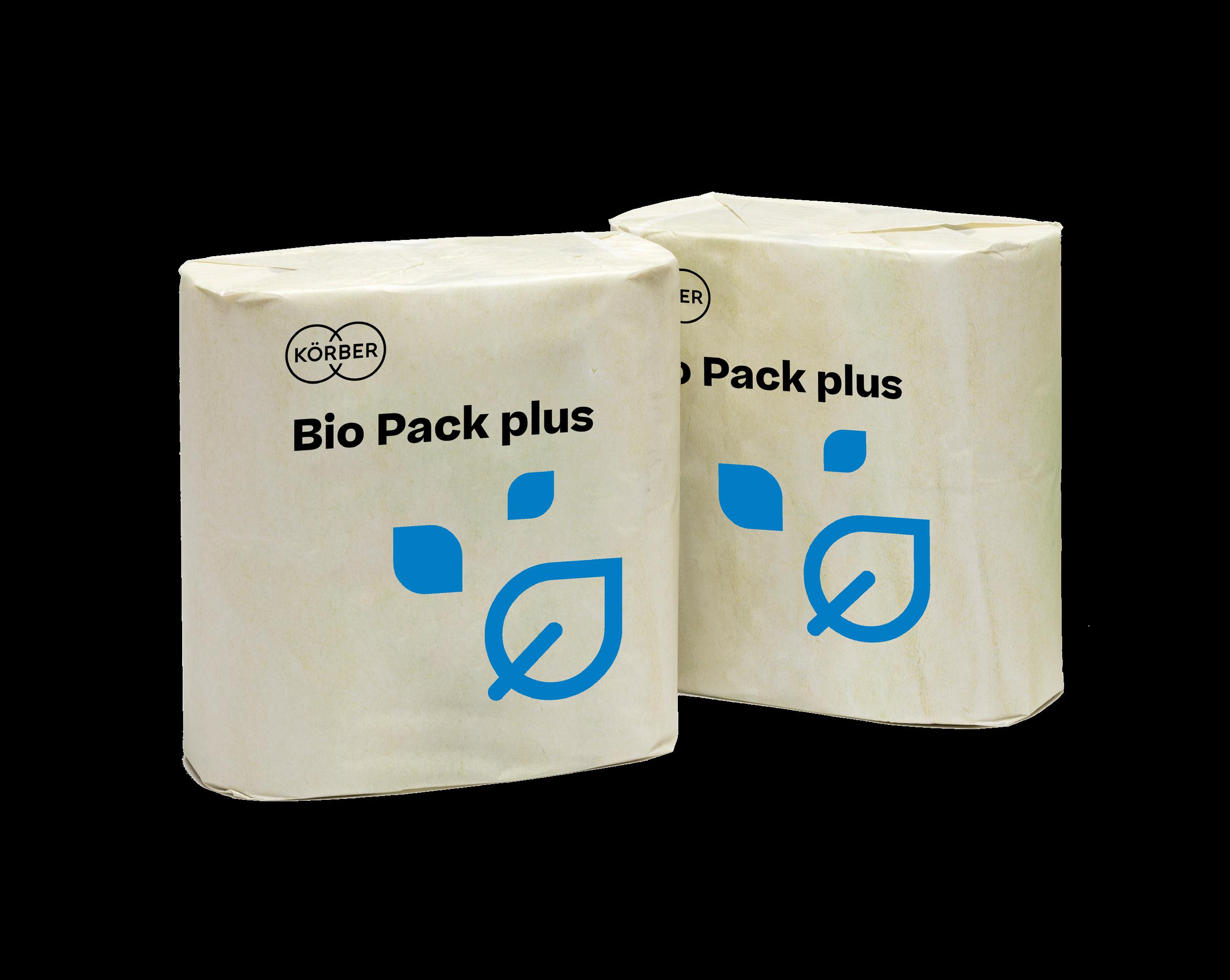
more:
Dicover
with the aim to build a more equitable and inclusive future for children in the sport. To date, Kruger Products has donated more than $600,000 to over 40 hockey communities across Canada, helping to make Canada’s game more financially accessible for all children.
Elsewhere, the upcoming return of the annual Cashmere Collection which will celebrate its 20th anniversary will also coincide with October’s Breast Cancer Awareness Month. This year, twenty Canadian designers will create couture garments from Cashmere Bathroom Tissue, as the brand raises funds and awareness for the breast cancer cause.
Fostering environmental stewardship also remains a key strategy for the company. The launch of Bonterra served as a testament to this commitment, it says. “As sustainability continues to become a greater priority for consumers, Bonterra offers sustainably focused bath tissue, paper towel, and facial tissue to meet their needs while doing something small, but impactful at the same time.”
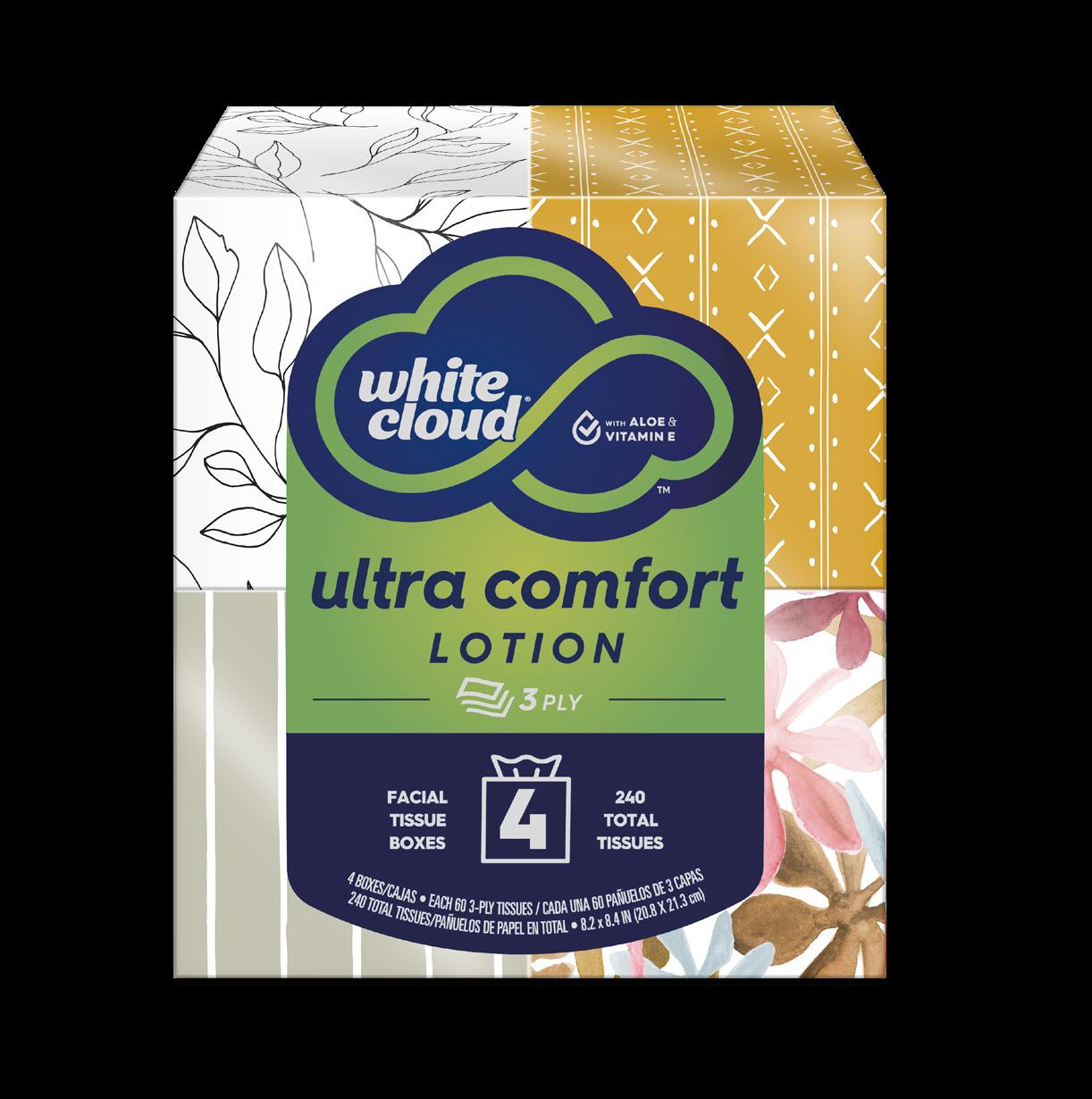
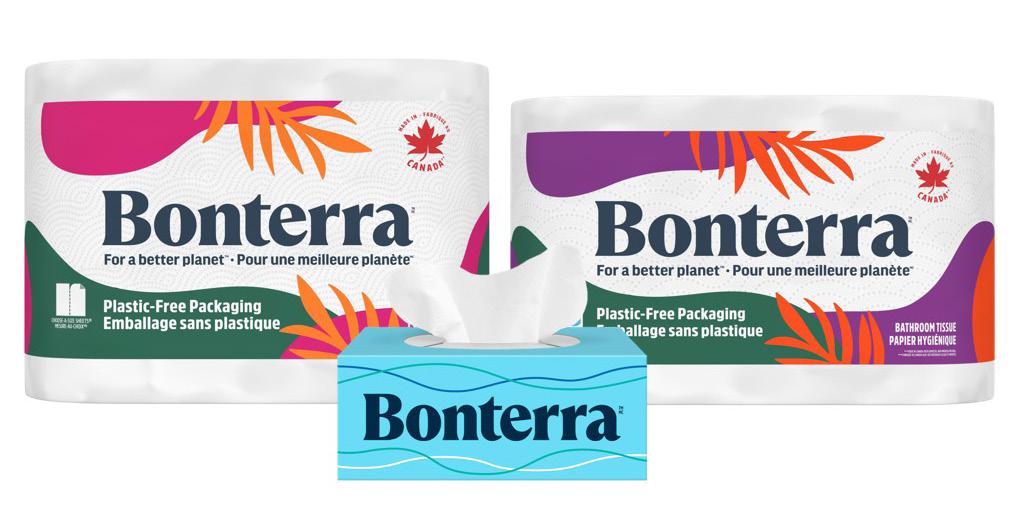
Reimagine 2030 is a strategic development plan launched by the company and centred on the belief that profitability and sustainability can harmoniously coexist. Anchored in four pillars – Products Empower, Planet Conscious, Employee Impact, and Community Embrace – the plan outlines targets for 2030, spanning the reduction of GHG emissions, water consumption, virgin plastic packaging, and the incorporation of third-party certified fibres.
Lastly, the Zibi Community Utility (ZCU) partnership in Gatineau, Quebec, recovers heat from the tissue-making process from the neighbouring Kruger Products’ Gatineau tissue plant and injects it into the new central energy plant, where the heat is upgraded and moved through a pipe network to the buildings. The company says the ZCU offers residents and visitors the opportunity to experience
the operations and immerse themselves in the innovative technology.
Looking ahead, Kruger Products says it “remains steadfast in leveraging its strategic investments to drive its growth and supply high-quality tissue products to customers across North America”. This trajectory is supported by “purpose-driven brand marketing and an ongoing commitment to sustainability”, further strengthening its position as an industry leader.
July/Aug | 33 www.tissueworldmagazine.com
The Bonterra brand: Kruger Products has introduced an eco-centric line featuring plastic free paper packaging
Tissue World Magazine | Operations Report
U.S. presence: The company continues to grow across America with its White Cloud brand and premium private label offerings
THE LOW CAPITAL DYNAMIC: RE-UTILISE
SHUT OR UNDER-USED FACILITIES … AND BUILD IN FLEXIBILITY FOR MULTI-CHOICE DIRECTIONS
With its latest investment – a PrimeLineTM W 2000 – started-up at its site in Duluth, Minnesota, in January this year, ST Paper is primed for further expansion. TWM interviews Senior Vice President and Chief Operating Officer Ron Thiry.
As the Teams video call opens, a framed image of what looks like the green and yellow of the Green Bay Packers dominates the central position of Ron Thiry’s office. Is it the famous NFL team celebrating a touchdown? “It is indeed!” he says. “I’m a Green Bay native. It’s in the blood!”
Born and bred in one of the world’s two key tissue hubs, Thiry’s career has taken him across stints at Georgia-Pacific, SCA, and Little Rapids, before joining family-owned independent tissue manufacturer ST Paper just under five years ago. Now the company’s Senior Vice President and Chief Operating Officer, he says he enjoys the flexibility of working for a fast growing, entrepreneurial company. The past few years have seen him fully involved in the company’s expansion, helping it navigate through the ups and downs of a global pandemic, acquiring a business, and overseeing the start-up of a new tissue machine that has added 30% production capacity to the business.

The group is now placed across three strategic locations in the US: its original mill site is based in Oconto Falls, Wisconsin, 30 miles north of Green Bay, and a second facility is in Franklin, Virginia, where the business has converted two fine paper
machines into tissue machines, creating its ST Tissue division and expanding into the east of America. In May 2021, it further boosted its production capabilities after purchasing Verso Corporation’s idled Duluth, Minnesota-based mill, where it then installed an Andritz-supplied PrimeLineTM W 2000 high-speed tissue machine that was started-up in January 2023.
It’s this ability to “successfully add capacity in different ways” that he says is vital. “We use a low capital investment approach by re-utilising facilities that have been shut down or underutilised. We feel we have a different angle to bring to the market.”
With a design speed of 2,000m/min and a working width of 5.65m, the new tissue machine uses 100% recycled wastepaper or virgin fibre and turns it into parent rolls of bath tissue, facial tissue, paper towels, and napkins. “Our business strategy is solely to produce jumbo rolls for some of the larger integrated players as well as the independent regional converters,” he says. “The design of the Duluth machine and the systems surrounding it gives us the flexibility to direct that volume towards retail applications as well as the AfH market.”
ST Paper embarked on the Duluth project when “Covid was still on top of us,” he says. “So while we were confident that the AfH market would recover,
34 | July/Aug www.tissueworldmagazine.com
Tissue World Magazine | Operations Report
no one could predict the timing. We had to make sure that we had the flexibility with this machine to go in multiple directions. We’ve already made products ranging from lightweight bath tissue to heavyweight towels with recycled fibre. We’ve made virgin pulp products, and some natural unbleached napkin and towel products. We’ve tested the flexibility of that operation.”
Anecdotally, he says he believes the American AfH market has rebounded close to 2019’s benchmark level, and that generally the country is back to a normal growth rate in the tissue market. “Over the years, tissue growth is typically 1-2% and we are probably back in that realm. At least from our vantage point, demand seems to be at that. For AfH, I think the mix of products has shifted a bit as fewer people are working from offices, so that may have affected the mix. But I’d say the hospitality side of the AfH market appears to be fairly healthy in the US.”
While there’s still “some noise” post-Covid with imports coming into the market or not coming into the market related to transportation costs and world economy, he’s at a point where he doesn’t want to keep continuing to use Covid as an excuse. “It’s new dynamics, certainly. Some companies weathered the whole Covid situation differently from others and we are seeing some reactions now in market dynamics taking place, perhaps partially because of what we all lived through.”
Will the North American tissue market likely see more M&A activity to help it re-balance? “Sure, there will be moving parts. In total the demand, the consumption, won’t change as fast. But things have a way of balancing themselves out over a period of time. Some companies have elected to take capacity out of the market, things move around. Other companies have gone through acquisition, repositioning. So there’s a good amount of dynamics happening. Some people are gaining business, others shedding it. For us, we need to follow who is taking care of that demand and make sure they are aware that we are here to step in and support them.”
With the Andritz start-up, does he foresee any product diversification for the company? “We will stay fairly close to our strike-zone, which is primarily the AfH segment of the market. The diversification would come with enhanced capability to service the At-Home market. Not only the machine capability that comes from Andritz but the capabilities we have at the Duluth site for handling virgin pulp, blending a variety of fibres. One of the key things that was attractive for us at the Duluth site was a very strong fibre recycling facility, and that is something we are looking to continue to leverage.”
Demand for recycling raw materials continues to be “high priority,” and Thiry says he hears more and more conversations about availability of white recycled grades, office paper and so on, in particular. “As fewer people are now working in the office, people are wondering if there will come a point in time when a certain number of products need to shift to virgin, or virgin recycled blends, to satisfy the fibre supply.”
Finding the skilled workforce is also a challenge, and he says businesses are always investing in automation and technology to reduce the labour intensity of those operations. “We are fortunate that half of our Duluth workforce had previous experience in the mill. They are quickly learning the nuances of making tissue, but their familiarity with the mill has been invaluable.”
The energy crisis, he adds, is another key challenge. “My understanding is that it is better here than it is in Europe, but we are feeling it as well. The natural gas market has also calmed down and stabilised, the electrical market here is undergoing some change as the emphasis is on greener power generation, and that is certainly driving higher rates across our portfolio.
At some point he adds it may make sense for the business to self-generate, using natural gas, or other readily available biofuels at the site, depending on whether the crisis levels off. “If it does level off maybe we can adapt, with a hard focus on energy conservation and consumption reduction. But we hope to see a stabilisation.”
July/Aug | 35 www.tissueworldmagazine.com
With the Andritz start-up, does he foresee any product diversification for the company?
Tissue World Magazine | Operations Report
“We will stay fairly close to our strike-zone, which is primarily the AfH segment of the market.”
The start-up in Duluth has been key in helping the business tackle such challenges, bringing it flexibility, increasing its production output, and enabling it to work with a range of customers. “The new machine has added 70,000tpy to our production capacity, so we are now producing 250,000tpy. As we don’t participate in converting, everything we sell is to other converters, the independent converters or the large integrated companies that have needs for specific products that they don’t have the ability or capacity to make to balance their supply chains. So nearly all of that 250,000tpy, say 90%, is directed towards the AfH market.”
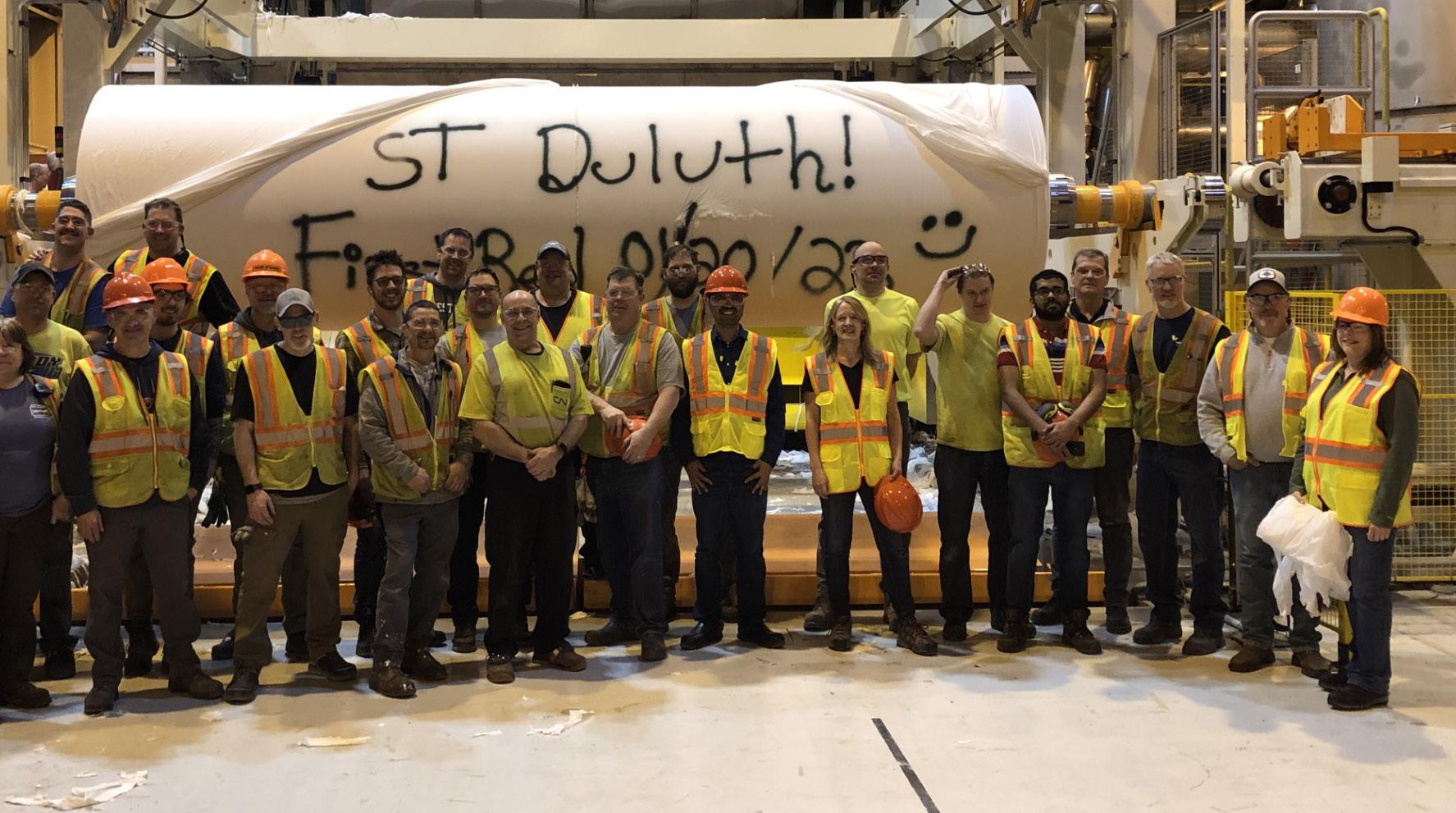
The business needs to follow its customers where the demand is, he says. “As we are basically a contract manufacturer, we are here to fill in the gaps in our customers’ supply chain. We’re not in a position where we design a machine or a process and push a product out into the marketplace. So it is important for us to have the flexibility and work with a range of customers. This means that there are different types of challenges, but it’s a good place to be. We are a lean organisation and that allows us to be involved with all aspects of the business.”
Further growth will also be a key strategy: “Our company is committed to continue to grow, and our challenge is to be there for our customers to help them grow. So absolutely we continually look for the right opportunities to satisfy that
growth. We bring a different angle to the market, and we will continue to look for those opportunities to be close to our customers to understand their requirements and look for the opportunities where we can execute a plan to effectively meet that.”
It is, as a Green Bay native would say, a matter of keeping the company on the offense.
36 | July/Aug www.tissueworldmagazine.com
Start-up team: the Duluth-based mill’s Andritz-supplied PrimeLineTM W 2000 high-speed TM started-up in January 2023
Tissue World Magazine | Operations Report
“As we are basically a contract manufacturer, we are here to fill in the gaps in our customers’ supply chain. We’re not in a position where we design a machine or a process and push a product out into the marketplace.”
Form a new attachment.
Get creping performance and tissue softness you’ll prize with Buckman Yankee coating.
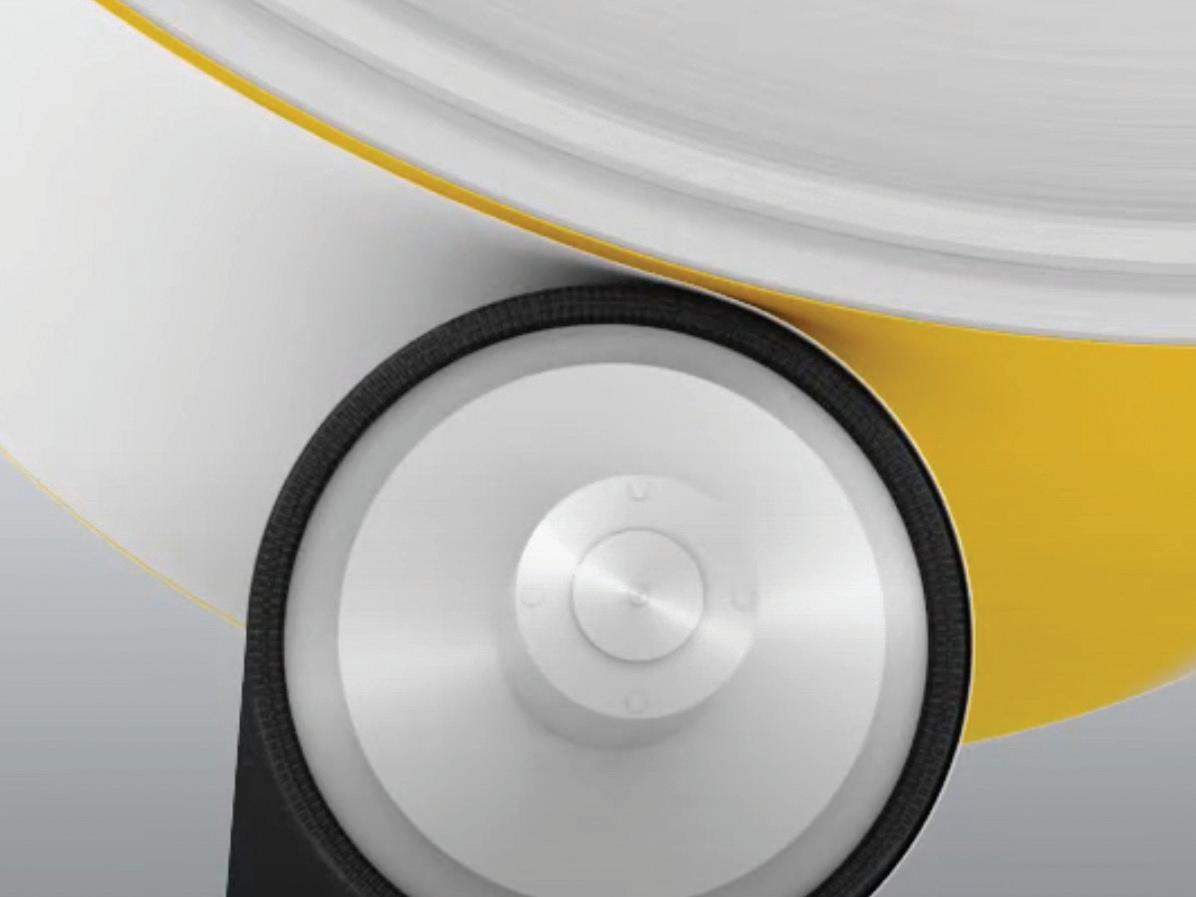
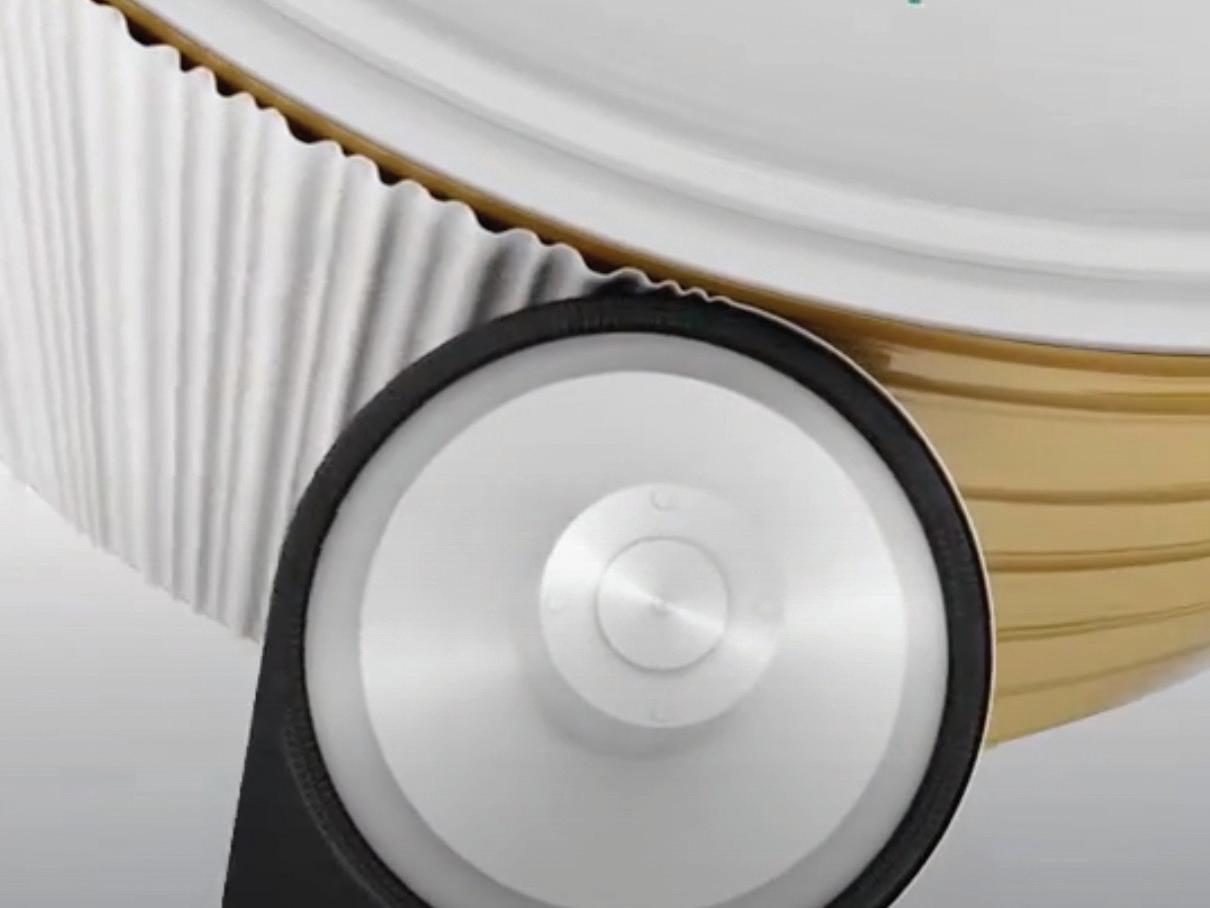
You can trace the success of your tissue back to the Yankee coating. Use one with poor attachment characteristics and you end up with a host of problems, the worst of which is a finished product that doesn’t live up to its promise.
Buckman Yankee coating is formulated for optimal sheet attachment at the pressure roll nip. So you get better heat transfer, consistent creping, and a more uniform exploding of the sheet for optimal softness. Plus its viscoelastic properties reduce chatter, prevent Yankee damage and extend blade and felt life. That’s performance anyone can become attached to. Scan the QR code to learn more via video animation or visit buckman.com.
© 2023 Buckman Laboratories International, Inc. All rights reserved.
CANFOR EMBEDDING LONG-TERM SUSTAINABILITY ACROSS ITS DAYTO-DAY BUSINESS
A global pulp leader is investing at least C$250m to reduce its GHG emissions, and plans to undergo the Science Based Targets initiative validation in 2024. Michelle Ward, Vice-President, Corporate Communications, details the ambitious and essential role businesses must play. A TWM report.

TWM/1: OVER THE LAST THREE YEARS, CANFOR HAS ANNOUNCED A CARBON TARGET AND SEVERAL OTHER METRICS TO ADVANCE ITS SUSTAINABILITY. WHAT ARE THE KEY AREAS WHERE YOU HAVE FOCUSED ON SUSTAINABILITY, AND HOW WILL YOU ACHIEVE YOUR CARBON TARGET?
“While Canfor and Canfor Pulp have always considered sustainability as core to our business, in late 2020 Canfor started on an ambitious sustainability journey to think differently about what we do and how we can drive benefits not only for our planet, but also for our people, communities, customers and through our products.
“We look at sustainability as providing for the present needs without compromising the needs of future generations. This requires us to prioritise sustainability – producing renewable, sustainable low-carbon products – for the long term, and Canfor Pulp are on a journey to embed sustainability across our businesses and into how we do business every day.
1 Air and water reduction targets from a 2020 baseline year
“After undertaking a detailed assessment on what was important to our customers and other stakeholders, we set goals in a number of areas including safety, inclusion and diversity, sustainable forestry, climate change, energy management, and others. Overall, we identified 13 topics and have performance targets for nine, with development of the additional four in progress. This is where we are focusing our sustainability efforts.
“For example, in the topic of Sustainable Forestry, one target we have is to maintain 100% certification to the Sustainable Forestry Initiative® (SFI) or Forest Stewardship Council® (FSC) for all Canfor-managed forests in Canada. This target has been achieved each year. We also maintain 100% certification to the SFI Fibre Sourcing Standard for all sourced wood in the United States. This assures customers that the pulp they purchase for their manufacturing is coming from third-party certified, sustainable sources.
“We also considering water and air quality in our pulp operations, beyond what is required of us by our regulators. In 2022 we set water and air quality targets1:
38 | July/Aug www.tissueworldmagazine.com
Tissue World Magazine | Technical Theme
CARBON CYCLE: A CANFOR ILLUSTRATION
• Reduce the total loading of particulate to the airshed by 10% by 2030
• Reduce the water intensity of pulp and paper production by 10% by 2030
• Reduce the biological loading intensity of pulp and paper production by 25% by 2030.
“To support each target, we are creating strategies that will support performance improvements as well as planning for any capital projects. Additionally, we use biomass as a source of energy which offsets fossil fuel use at our pulp mills.”
TWM/2: CANFOR HAS ANNOUNCED TARGETS TO REDUCE ABSOLUTE SCOPE 1 AND 2 GHG EMISSIONS BY 42% BY 20302. IN TERMS OF PULP FOR THE TISSUE AND TOWEL MARKETS, CAN YOU ELABORATE ON WHAT THAT WILL INVOLVE FOR THE TISSUE AND TOWEL MARKETS?
“Climate change is one of the most urgent issues society is facing today. Sustainable forestry and the products that the forest sector provides are critical to addressing climate change. One of the best tools we have to address climate change is a healthy working forest to provide the base fibre we need.
“Forest products, such as pulp, lumber, mass timber, and bio-innovative products are the only fully renewable, compostable, recyclable, and reusable materials widely available to the consumer.
“Businesses have an essential role to play in transitioning to a low-carbon economy, and

2 From 2020 baseline year
Canfor and Canfor Pulp are joining many global peers in setting appropriate targets and a net-zero goal. Canfor, Canfor Pulp and other organisations all need to evolve our practices to help reduce GHG emissions globally. Setting appropriate targets and a net-zero goal are critical steps in transitioning to a low-carbon economy.
“In April 2022 Canfor and Canfor Pulp set a shared GHG target to reduce our scope 1 and 2 GHG emissions – the emissions we produce and those that come from energy we use – by 42% by 2030. Scope 3 emissions are defined as indirect emissions, such as those that come from the value chain, including transportation, supply chain, or use or disposal of products. In 2021 we estimated our scope 3 emissions and are working on improving

July/Aug | 39 www.tissueworldmagazine.com
Climate change is one of the most urgent issues society is facing today. Sustainable forestry and the products that the forest sector provides are critical to addressing climate change.
Tissue World Magazine | Technical Theme
scope 3 data collection and quantification annually to set a specific scope 3 target.
“Our overall climate goal is to be net zero by 2050. To ensure that we set a target that is aligned with the Paris Agreement’s recommendation to limit global warming to 1.5°C, we have committed to set a science-based target with the Science Based Targets initiative (SBTi). Canfor plans to undergo the SBTi validation process by April 2024. The SBTi publishes a corporate standard for net-zero target setting, and alignment with this standard is an important step towards our shared global climate change goal.
“Part of the process of setting a target is to ensure we had the capacity and pathway to achieve it. We developed a decarbonisation road map as part of the process, involving teams from across our North American business units including Energy Managers from our pulp team. This road map will focus on several areas:
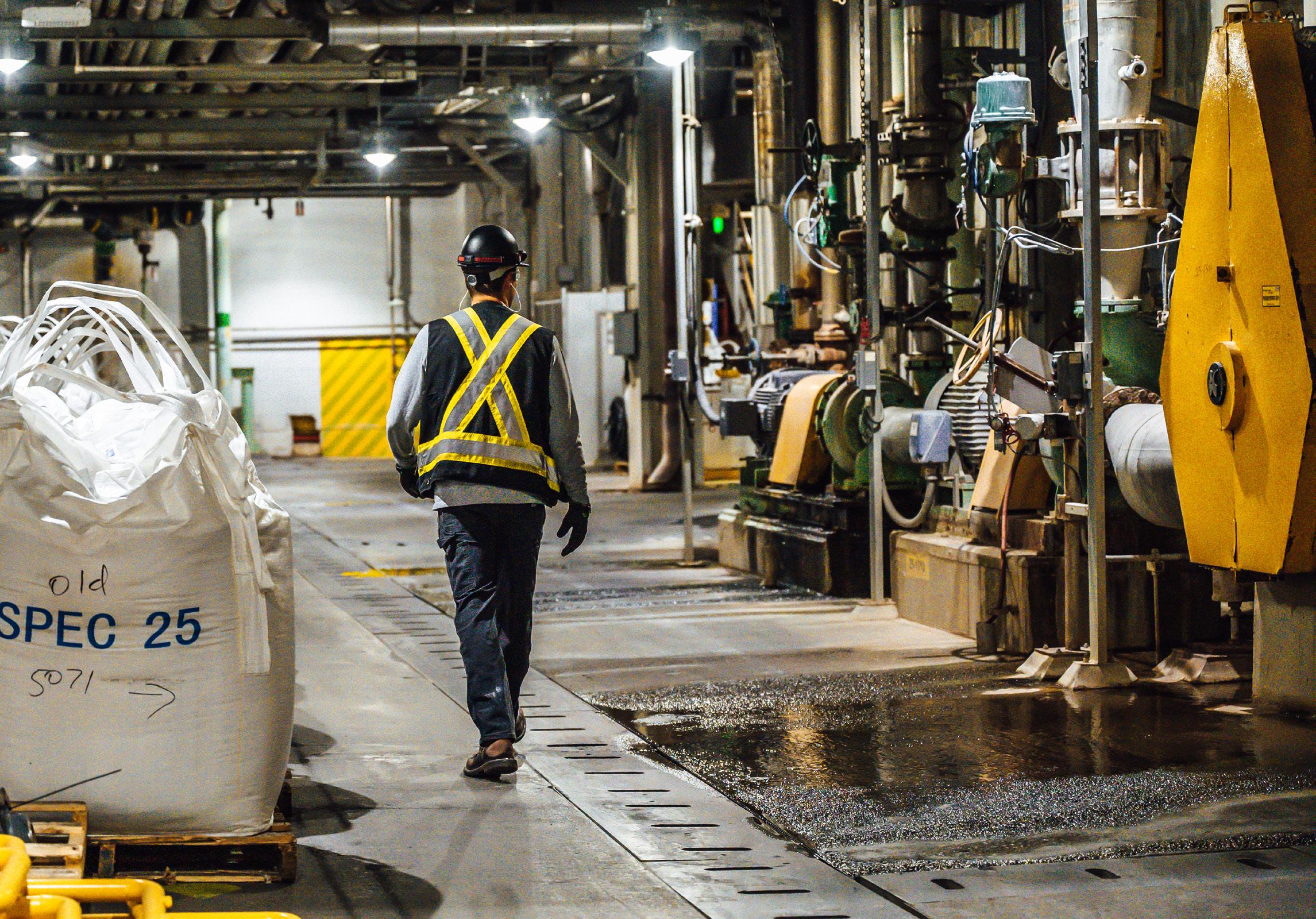
1/ Energy and Process Efficiency
Implementing strategies and technologies to improve energy and fuel efficiency in existing infrastructure and vehicles.
2/ Fuel Switching
Switching from higher-emission fuels to loweremission fuels such as biofuels, biodiesel, renewable natural gas, hydrogen and biomass.
3/ Electrification
Electrification of vehicles and stationary mobile equipment.
4/ Investing in Renewables
Producing or procuring electricity from renewable sources.
5/ Other Innovative Technologies
Continuing to investigate and invest in emerging technologies and solutions that will help us reduce emissions in the long term, such as carbon capture, utilisation and storage; hydrogen fuel; and direct air capture.
“We also committed to investing at least C$250 million in projects that will help reduce our emissions. The full decarbonization strategy is in development and will outline the detailed areas
40 | July/Aug www.tissueworldmagazine.com
Tissue World Magazine | Technical Theme
GHG target: In April 2022, Canfor and Canfor Pulp set a shared GHG target to reduce scope 1 and 2 GHG emissions by 42% by 2030.
where Canfor and Canfor Pulp will focus over the next several years.”
TWM/3: SPECIFICALLY IN TERMS OF TECHNICAL INNOVATIONS, WHAT IS CANFOR DOING IN RESPONSE TO CUSTOMER DEMAND FOR SUSTAINABLE TISSUE AND TOWEL PRODUCTS?
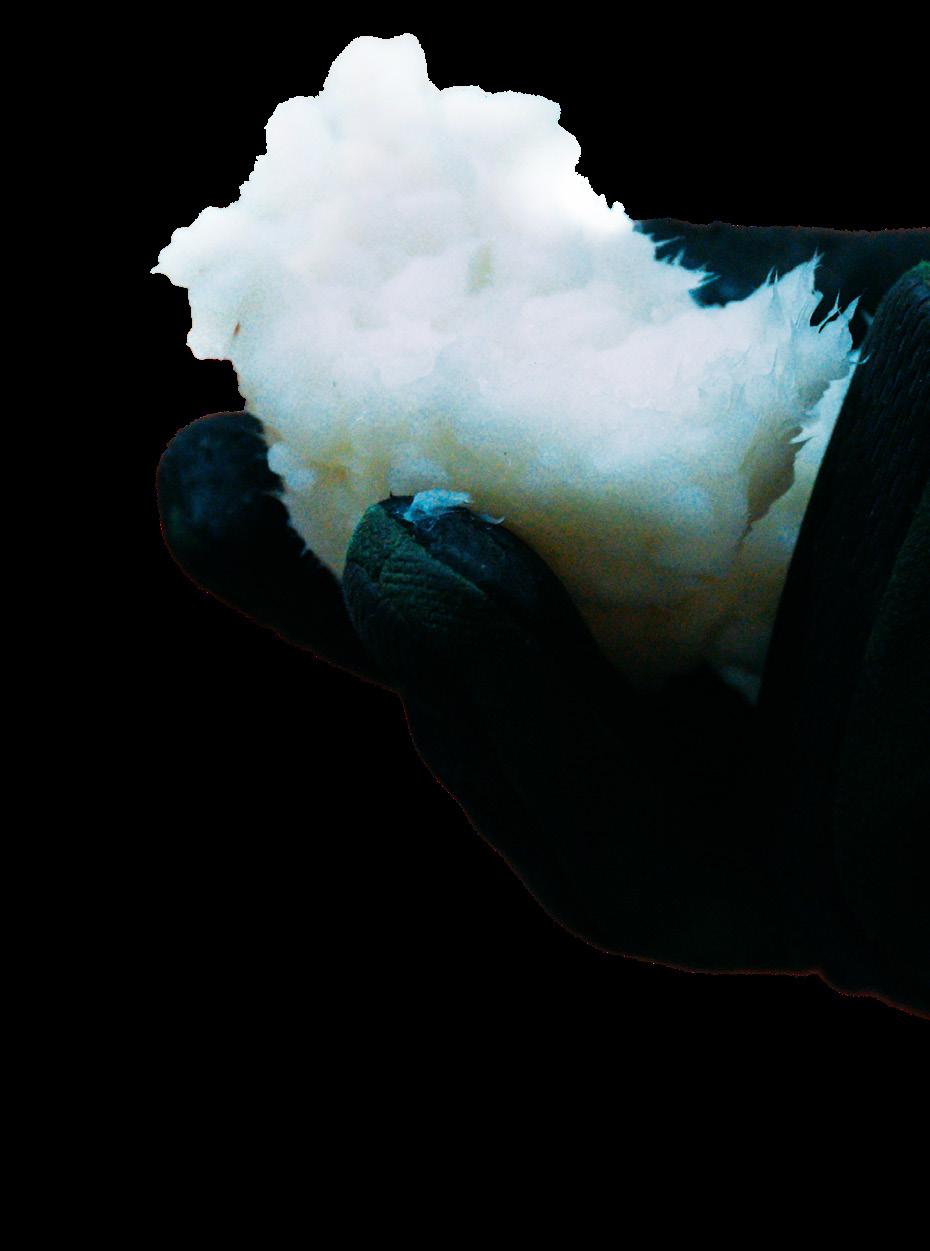
“Our main technical initiative for the tissue sector is the elimination of talc from our mills. Canfor Pulp’s Intercontinental kraft mill is already talc free, and we are currently working to make the Northwood kraft mill talc free as well. This involves mill employees working with chemical suppliers to ensure that we can maintain overall pulp cleanliness for all our customers, while eliminating talc.
“We continue to work with our customers in the hygiene paper sector to ensure that they are obtaining the highest value from our pulps. Premium toilet and facial tissue producers prefer Canfor bleached softwood pulps because they can get the strength they need with low levels of refining. Less refining increases bulk and improves softness in premium tissue products. We have presented these findings at the 2020 Tissue World conference in Miami.”
TWM/4: IN JANUARY 2023, CANFOR ANNOUNCED IT WILL PERMANENTLY CLOSE ITS PRINCE GEORGE PULP AND PAPER MILL, RESULTING IN A REDUCTION OF 280,000 TONNES OF
UNBLEACHED SOFTWOOD KRAFT PULP ANNUALLY. IS THIS A CHANGE IN DIRECTION FOR CANFOR?
“We have been facing significant headwinds regarding short-term fibre supply due to sawmill curtailments, as well as a very significant long-term shortage of economic fibre due to reductions in the annual allowable cut and chip availability. In January 2022 we made the difficult decision to close Canfor Pulp’s Prince George Kraft mill.
“Sustainable forest management will ensure that Canfor Pulp will continue to supply high quality bleached and unbleached softwood kraft pulps to the tissue sector through the Intercontinental and Northwood kraft mills.”
TWM/5: IN TERMS OF PULP FOR TISSUE AND TOWEL PRODUCTION, WHAT KEY R&D AREAS WILL THE NEXT FIVE YEARS BRING FOR CANFOR?
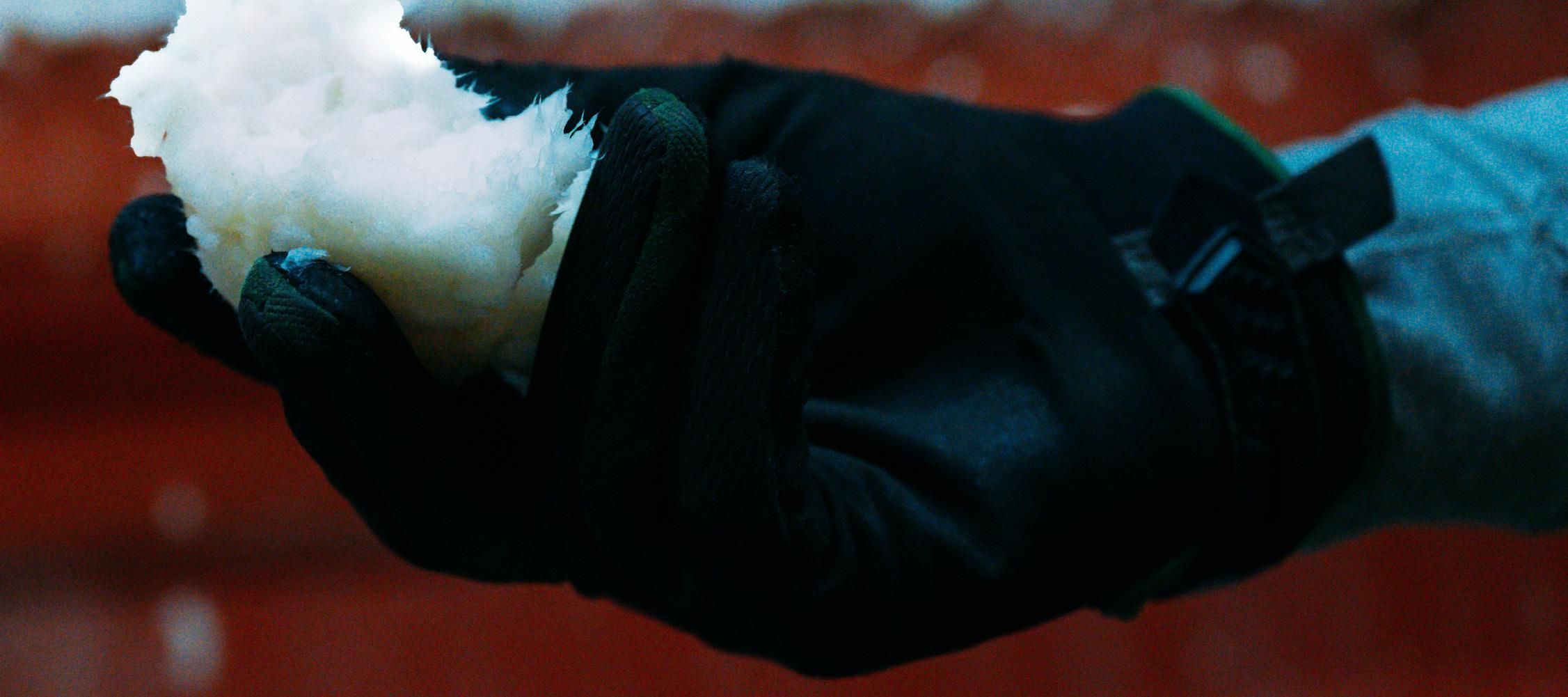
“Canfor Pulp had a long partnership with the Voith Pilot Tissue Machine located at its Innovation Centre in São Paulo, Brazil. Through this collaboration, we were able to investigate the benefits of using our bleached pulps in premium grades of toilet tissues, facial tissues, and towel products.
“Our work in the tissue sector is now focusing on further improvements in pulp quality that will be of direct benefit to our tissue customers. From their feedback, Canfor Pulp is focusing on eliminating talc from our pulping processes, enhancing our fibre quality to optimise tissue softness and bulk, and reducing the environmental impact of our products by reducing our overall GHG emissions.”
July/Aug | 41 www.tissueworldmagazine.com
Tissue World Magazine | Technical Theme
Pulp quality: Canfor Pulp is focusing on eliminating talc from its pulping processes, enhancing its fibre quality to optimise tissue softness and bulk
UPM’S $3.47BN INVESTMENT IS LARGEST IN ITS HISTORY
‘Step change’ project includes new pulp mill in Paso de los Toros, a new terminal at Montevideo’s deep sea port, community developments in housing, landfill and waste water treatment ... and a more than 50% increase in pulp capacity. Sari Hörkkö, Director, Pulp Communications and Marketing, UPM Fibre, explains. A TWM report.

In spring UPM celebrated a significant milestone with the completion of its transformative growth investment in Uruguay. Over the years UPM has worked to create a modern industrial platform with world class pulp mills, sustainable and secure wood supply, and efficient logistics in Uruguay.
The UPM Paso de los Toros mill started operations in Centenario, central Uruguay, near the city of Paso de los Toros in mid-April. Despite the pandemic, the mill start-up took place just 44 months after construction work began in 2019.
The first customer deliveries from the new plant were shipped from UPM’s equally new pulp terminal in the port of Montevideo in May – they had already reached the first customers in China in July. Currently UPM is successfully implementing the mill’s ramp-up phase towards reaching full production capacity of 2.1 million tonnes of bleached eucalyptus kraft pulp annually.
The pulp mill has been designed as an efficient single-line operation representing state-of-the-art production in the industry, using the best available techniques (BAT). The machines, materials, level of automation and standards enable safe operations, high operating rate, and optimal maintainability. The plant’s environmental performance is verified with comprehensive and transparent monitoring.
STEP CHANGE TO TOP LEAGUE
Together with the annual 1.3 million tonnes eucalyptus pulp capacity from the UPM Fray Bentos mill in the southwest of Uruguay, UPM’s total eucalyptus pulp production capacity in Uruguay will increase to 5.8 million tonnes a year. In addition, this expansion will raise the position of UPM and the country of Uruguay among the world’s biggest sources of eucalyptus pulp.
UPM Uruguay’s Vice President, Pulp and Forestry Operations, Marcos Battegazzore, says the company now has 16 years’ experience running the UPM Fray Bentos mill and more than 30 years’ experience in sustainable forestry in Uruguay. He says that this combined experience, developed expertise, and R&D foundation provides the business with “a unique end-to-end view of the entire value chain.” It means the business can offer “a competitive and secure pulp supply to our existing and new customers and helps meet the globally growing need for renewable materials. With an increase of more than 50% in UPM’s current pulp capacity, this investment creates a step change in the scale of our pulp business and UPM’s future earnings.”
Besides the Paso de los Toros pulp mill, the project has included building a new pulp terminal in the deep sea port of Montevideo, as well as local facilities such as housing and improved municipal landfill and waste water treatment in
42 | July/Aug www.tissueworldmagazine.com
Tissue World Magazine | Technical Theme
nearby communities. The total investment adds up to USD3.47bn and is the largest ever in the history of UPM.

The terminal is a core piece in the operation of the Paso de los Toros pulp mill. It’s used for receiving, handling, and storing pulp and chemicals needed in pulp production. Operational since October 2022, this highly specialised, fit-for-purpose terminal targets maximum efficiency, with 100 people working in three shifts.

Andrés Rey, Senior Manager from UPM’s Industrial Logistics team in Uruguay, has been part of the terminal project from the design phase. “The terminal works 24/7 every day of the year and it can handle over two million tonnes of pulp annually. A total of 50,000m2 of warehouse space has been built for the terminal operations – enough to store 150,000 tonnes of pulp.”
The dock at the Montevideo port has been built to allow larger vessels to enter the port for cargo loading. “Our pier is 240 metres long and can accommodate vessels up to 225 metres long, with approximately 50,000 tonnes of pulp intake.”
The dock can also handle operations of two very different types of vessels, making it unique in the industry: the pier can serve both tankers with liquid cargoes and general cargo vessels, with minor
adjustments required and less idle time in between. In addition, the company has pulp handling tools and systems that cause the least damage to the cargo.
The project also includes a 12,000m2 roofed unloading area which allows the unloading of cargo directly to the warehouse in all weather conditions. Furthermore, the terminal features fully centralised systems to boost logistics.
To get the pulp from mill to port UPM will use the rail line on which the Uruguay state is putting the finishing touches to create an improved –and mostly rebuilt – railroad. There is full railway access planned but it’s not yet operational. In the meantime, the company uses trucks as an alternative means of transport. Along with pulp heading to the port, trucks are also travelling to the mill with raw materials for pulp production.
UPM will be one of the main users of the 273-kilometre rail connection leading from Paso de los Toros to the capital. The state-owned railway is open to other users as well, including passenger trains.
As the government is finalising the railway connection, UPM is ready to gradually shift logistics from road to rail.
July/Aug | 43 www.tissueworldmagazine.com
Tissue World Magazine | Technical Theme
‘Step change’: The UPM Paso de los Toros mill started operations in Centenario in mid-April
RESEARCH BASED EUCALYPTUS EXPERTISE
To secure the availability of high-quality eucalyptus seedlings for its plantation expansion UPM has opened its third tree nursery. A forestry research centre specialising in eucalyptus plantations was inaugurated in May 2022, bringing together more than 30 years of the company’s accumulated knowledge.
Ricardo Methol, Senior Manager, Technical Development & Planning at UPM Uruguay, says the work originated in the early 90s, when the focus was on testing and selecting such species of eucalyptus trees that could adapt well to local growing conditions.
“There are over 500 species in the eucalyptus genus and we chose two of them that provide the best performance – Eucalyptus grandis and E. dunnii – as the main species to be planted in Uruguay. At the time, the dunnii species was not at all well known in Uruguay nor in the pulp industry globally, but now it is the most planted eucalyptus species in the country,” he says.
Over the decades UPM has worked on improving the genetic material of the trees to achieve better productivity. An important step was taken in 2000 when the company began to propagate its trees from cuttings instead of just from seeds.
BOOSTING THE ENTIRE VALUE CHAIN
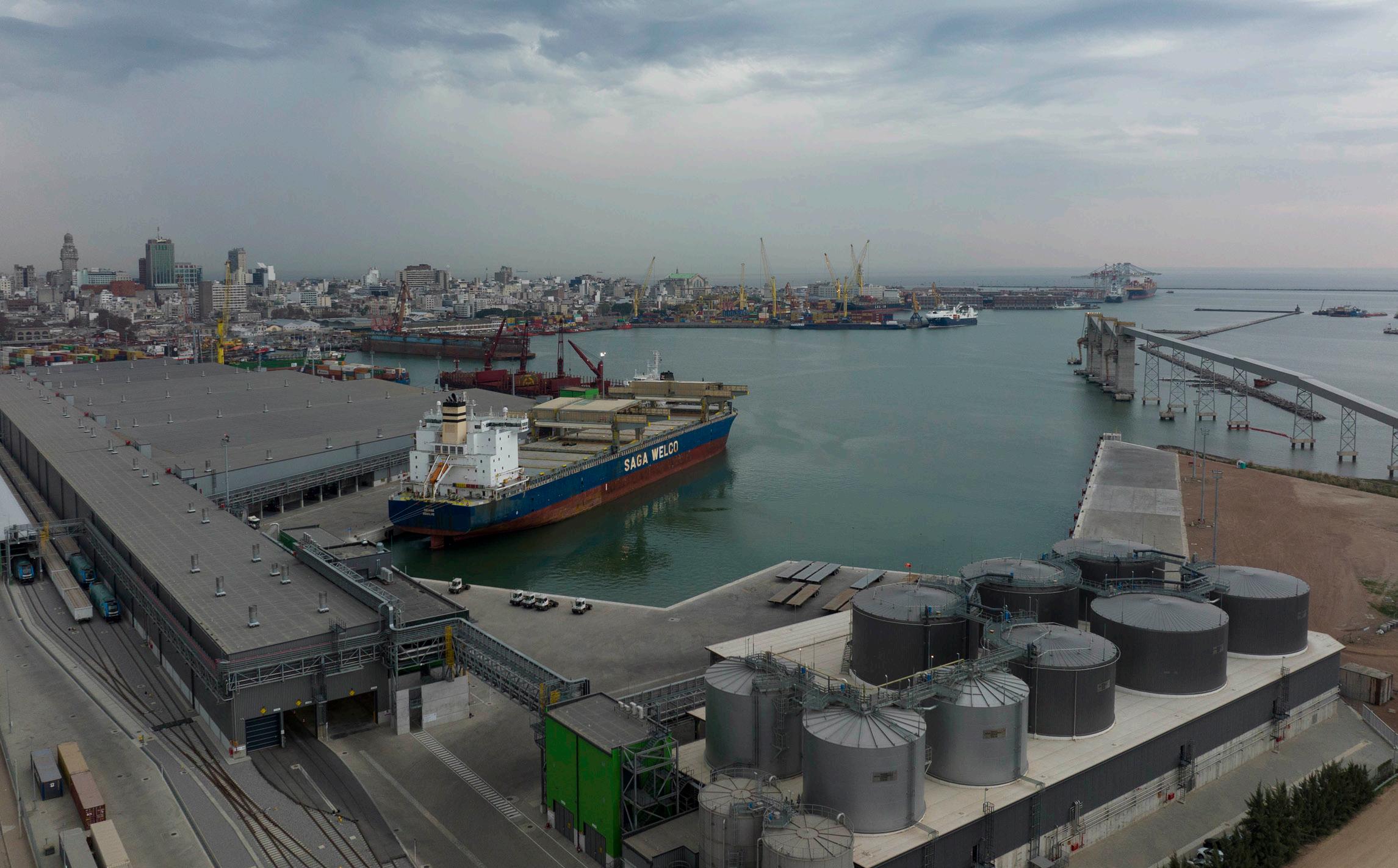
The new centre employs around 60 people, including agronomists, experts in genetic improvement, health, forestry research and wood quality, as well as chemical technologists and operators. High productivity, wood quality and good tolerance to pests and diseases are the current focus areas of the centre’s research work.
R&D is looking to make improvements to the characteristics of the trees and increasing the efficiency and accuracy of identifying the best candidate clones is crucial for that. Testing new candidates against harsh environmental conditions caused by climate change such as frost and drought has also become more important.
Before a tree clone is confirmed for operational use, it takes around 15 years of testing hundreds of candidates, out of which only one or two are selected. This requires a lot of resources for testing, trials, and evaluation. The laboratories, equipment and greenhouses of the new research centre provide UPM’s skilled experts with a state-of-the-art infrastructure.
Methol says: “With the inauguration of our new Paso de los Toros pulp mill and the third tree nursery, the scope of our work more than doubles, so the new centre provides a necessary boost. R&D is strategically critical for the company, as
44 | July/Aug www.tissueworldmagazine.com
Tissue World Magazine | Technical Theme
UPM’s pulp terminal at Montevideo’s deep sea port: the dock has been built to allow larger vessels to enter for cargo loading


we are not only looking at optimising forestry operations but also selecting materials with the best characteristics for pulp production and fibre properties for customers. UPM is a global pioneer, especially in the research related to Eucalyptus dunnii.”
UNIQUE PULP QUALITIES
UPM Euca is made from two main wood species – Eucalyptus grandis and Eucalyptus dunnii – that differ somewhat from the world’s main sources of eucalyptus fibre in Brazil, Chile, and the Iberian Peninsula.
Eucalyptus grandis has a high growth rate and high fibre number, while Eucalyptus dunnii has good frost resistance and high wood basic density. The ratio between the wood species determines the eucalyptus pulp properties to a large extent. When these two eucalyptus species are combined in UPM Euca, the end result is a well-balanced pulp, providing excellent quality, stability and good runnability, high brightness and easy refinability. UPM Euca provides good bulk when refined to required tensile strength to produce soft and smooth tissue products.
This article was written for TWM by Sari Hörkkö, Director, Pulp Communications and Marketing, UPM Fibres.
PORTFOLIO WITH THE BEST OF NORTH AND SOUTH
UPM provides a selection of softwood and hardwood pulp grades from its five mills on two continents:
• Northern bleached softwood kraft pulp UPM Conifer from the UPM Kaukas, UPM Kymi and UPM Pietarsaari mills in Finland
• Northern bleached birch kraft pulp UPM Betula from UPM Kymi and UPM Pietarsaari in Finland
• Bleached eucalyptus kraft pulp UPM Euca from the UPM Fray Bentos and UPM Paso de los Toros mills in Uruguay.
UPM’S OPERATIONS IN URUGUAY:

• UPM’s first eucalyptus seedlings were planted in 1990
• Today its three tree nurseries generate over 40 million eucalyptus seedlings a year
• The Fray Bentos pulp mill set a benchmark for a pulp mill in Uruguay in 2007
• The Paso de los Toros pulp mill started operations in April 2023.
46 | July/Aug www.tissueworldmagazine.com
Tissue World Magazine | Technical Theme
UPM’s Uruguay eucalyptus plantations: today its three tree nurseries in the country generate over 40m eucalyptus seedlings a year
THE TISSUE FACTS ON THE GROUND… SEEING THE FOREST, AND THE TREES
Industry analyst Greg Grishchenko – comparing the reality to sometime public perception – reveals just how responsible the industry has been with its forestry and bleaching programmes.
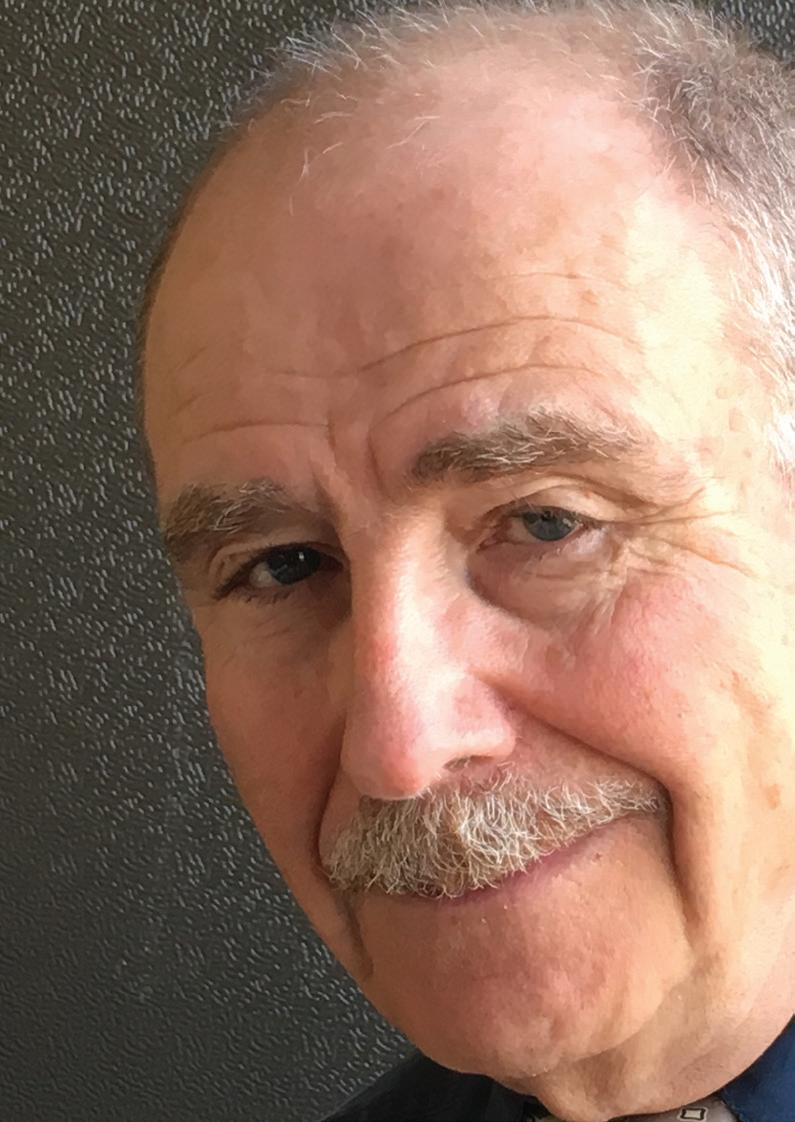
An average American household is ahead of households in every nation on earth in consuming tissue goods. Indeed, according to the German market research platform Statista, a person in the US on average uses about three rolls of toilet paper every week.
If multiplied by days and head count it comes to $16bn in the toilet paper revenue segment for the year 2023 (Statista). In purely volume terms, this amount comes second to a record breaking $22.3bn for China. Considering population size difference, America will keep its place in toilet paper consumption for years to come.
While 90% of bath tissue is North America is made from local sources and by local manufacturers, the remaining share of the market represents an attractive opportunity for small business enterprises both domestic and foreign to fill this niche. Ways and means of such businesses mostly based on environmental concerns merged conveniently with the modern world’s health and political issues. The competitive economic part in its marketing models may or may not always prevail.
SCORECARD – WINNERS AND LOSERS
Recently released is the latest (2022) annual report from the US-based Natural Resources Defense Council (NRDC), a half-century old non-profit
international environmental advocacy group, with its ranking of sixty top toilet paper brands sold in the country. The scoreboard – The issue with tissue 4.0 scorecard: A buyer’s guide to the sustainability of At-Home tissue products – aims to show how ecologically-friendly our choice brands are and provides grade ranking from A+ to F.
The NRDC scoring system which was used on toilet paper brands is awarding the highest score of up to 600 points to non-users of virgin wood fibre and harmful chemical technology like chlorine bleaching. Additional points are given for utilising recycled “postconsumer” materials or non-wood fibre like sugarcane bagasse, bamboo, or wheat straw. Some scoring points can be won also for “pre-consumer” recycled matter, employed internally during production process. Still the entire score for the latter is lower than that for “pre-consumer”, which is given for recycled items coming from eco-conscious people. Only four toilet paper brands received A+ rating. The “champion” brands are Green Forest, Natural Value and two private labels from health food grocers Trader Joe’s and Whole Foods. All of them use 100% recycled fibre. There is just one brand included in the second tier with B+ and B rating coming from one of the major market players, Kimberly-Clark –Scott Essential, with 100% recycled content. The rest represent several bamboo paper suppliers with brand names like Cheeky Panda, NooTrees
July/Aug | 47 www.tissueworldmagazine.com
Tissue World Magazine | ExitIssues
and Who Gives a Crap (WGAC). The latter displays an impressive list of “green” and political claims including 100% bamboo sourcing, biodegradability, carbon neutral shipping and 50% profits donation to sanitation improvements in the developing world. One issue is whether NRDC takes into account the carbon neutrality of the online brand shipped by the Australian company from Chinese production sites using process bleaching.
The failing grade F was given to almost a bottom half of the list, best-selling brands including Charming, Angel Soft, Cottonelle Ultra and Scott 1000. According to NRDC, the “losers” of the product line-up were given the lowest possible score for bringing deforestation and pollution to our habitat by using entirely virgin wood fibre and chlorine bleaching.
HABITAT AND HUMANS
Inevitably, as humankind improves living conditions through the production of food and other goods, population numbers increase and our surroundings and environment change. Tissue, a segment of a much larger paper industry, is sometimes charged with being largely responsible for damage to our forests. Numerous government, public and private organisations have been established to protect wild forests and mitigate the negative impact of the paper industry on global climate, wildlife and indigenous people. We can only speculate as to why tissue goods are singled out for criticism, but not the other sectors like log houses, or art books of children’s toys – the latter is made of 100% natural wood in China from Russian pine trees growing in Siberia. Probably, short life cycle, and disposability create that image.
Let’s consider a few facts about deforestation. Both owners of F-grade rated brands Charming and Angel Soft – Procter & Gamble and Georgia-Pacific – declare replanting two or three trees (respectively) for every tree they cut.
According to Statista, for 900m trees that are harvested annually about 2.5bn trees are replanted. NRDC often contests the value of tree replanting, claiming that the areas where wild forests were clear-cut and replanted by paper corporations are not ecologically equal for wild life species.
In the meantime, only this year 20m acres of Canadian boreal forest were lost due to catastrophic wildfires, and it is impossible to reforest it to the level previously used. Replanting value allegations could be raised for natural events (including wildfires) taking place in North America every year from May to October. Still the guilt has been laid on paper companies.
Bleaching in modern tissue production, often seen by public opinion as an environment polluter,
is also misunderstood. Nowadays in North America, not a single considerable tissue manufacturer uses elemental chlorine. Instead, they either apply “totally chlorine-free” (TCF) or “elemental chlorine-free” (ECF) technology. TCF pulp has been bleached without any type of chlorine. ECF process uses chlorine derivatives especially for recycled fibre and bamboo imports due to high amounts of inks and dyes.
POLITICS, HEALTH AND PUBLIC OPINION
Seventh Generation brand is a success story of a brand with A rating from NRDC. This brand was originated and developed almost entirely on human perception of preserving nature. According to Jeffrey Hollender, the founder of Seventh Generation, the marketing concept of the start-up company began with sending the brand promotion materials to the mailing list of people who made donations to various funds associated with ecological causes.
Many years ago while visiting a major tissue producer in Canada, I noticed a Seventh Generation bath tissue packaging line at one of the affiliated mills. At the end of my visit, I was asked not to disclose any reference to this brand in my trip report. This request was not unusual due to the fact that often private label brands prefer to keep their manufacturing sources confidential.
Indeed, many “green” brands are manufactured by big paper companies using their venue and technology. The sourcing of such brands and their affiliation with major tissue mills, especially located in Asia, remains the best kept secret.
48 | July/Aug www.tissueworldmagazine.com
Tissue World Magazine | ExitIssues
Tissue, a segment of a much larger paper industry, is sometimes charged with being largely responsible for damage to our forests.
Another hidden point that never comes to light is a carbon footprint. While the negative impact of CO2, the most commonly produced greenhouse gas, has never been denied in paper manufacturing, the similar result of selling imported tissue goods from faraway places has been somehow missing. The majority of B-graders in NRDC score card, non-wood fibre brands (mostly bamboo or sugarcane) are sourced in Asian countries like China or India. Shipping jumbo rolls or finished bath tissue rolls made of compostable and biologically friendly items halfway across the globe will generate quite large carbon footprints – and ones that have not been considered by promoters of “green” issues.
Even though the majority of American bath tissue consumers establish purchasing decision almost entirely on cost and tactile perception, the annual brand scoring review from NRDC represent its powerful opinion based almost entirely on nature protection while mostly ignoring consumers’ health issues rising from the use of recovered paper. While recycled paper is considered the best option for the environment, there is one stealthy little secret in secondary paper essence – bisphenols, used to produce polymers and resins such as BPA and BPS, which are then used to make plastic materials.
BPA and BPS have been discovered as a hideaway inside recycled bath tissue. (Yet it is important to note that Bisphenol compounds are found throughout the contemporary world in the form of plastics used extensively by consumers for food storage, baby formula, dental implants, sales receipts, shatterproof windows, eyewear, water bottles, and epoxy resins that coat some metal food cans, bottle tops, and water supply pipes, etc.)
In recycled bath tissue, this issue is linked to thermal paper (as well as the other printed
900m
secondary paper) which is contaminated with bisphenols and ends up in mixed post-consumer stock material. Bisphenol A (BPA) is an endocrine disruptor. Studies have linked them to breast cancer, reproductive problems, and early puberty. Recently, the state of the tissue business in North America was tested for vulnerabilities during the Covid pandemic. The results were mostly encouraging. The major players and F-graders (according to NRDC) like Procter & Gamble, Georgia-Pacific and Kimberly-Clark have shown the ability to bring the comfort of recovery to a scared consumer, while A-graders struggled to adjust due to their distinct business models.
2.5bn
July/Aug | 49 www.tissueworldmagazine.com
The annual brand scoring review from NRDC represent its powerful opinion based almost entirely on nature protection while mostly ignoring consumers’ health issues rising from the use of recovered paper
Trees harvested annually, according to Statista
Tissue World Magazine | ExitIssues
Trees are replanted, according to Statista
IN THIS ISSUE...
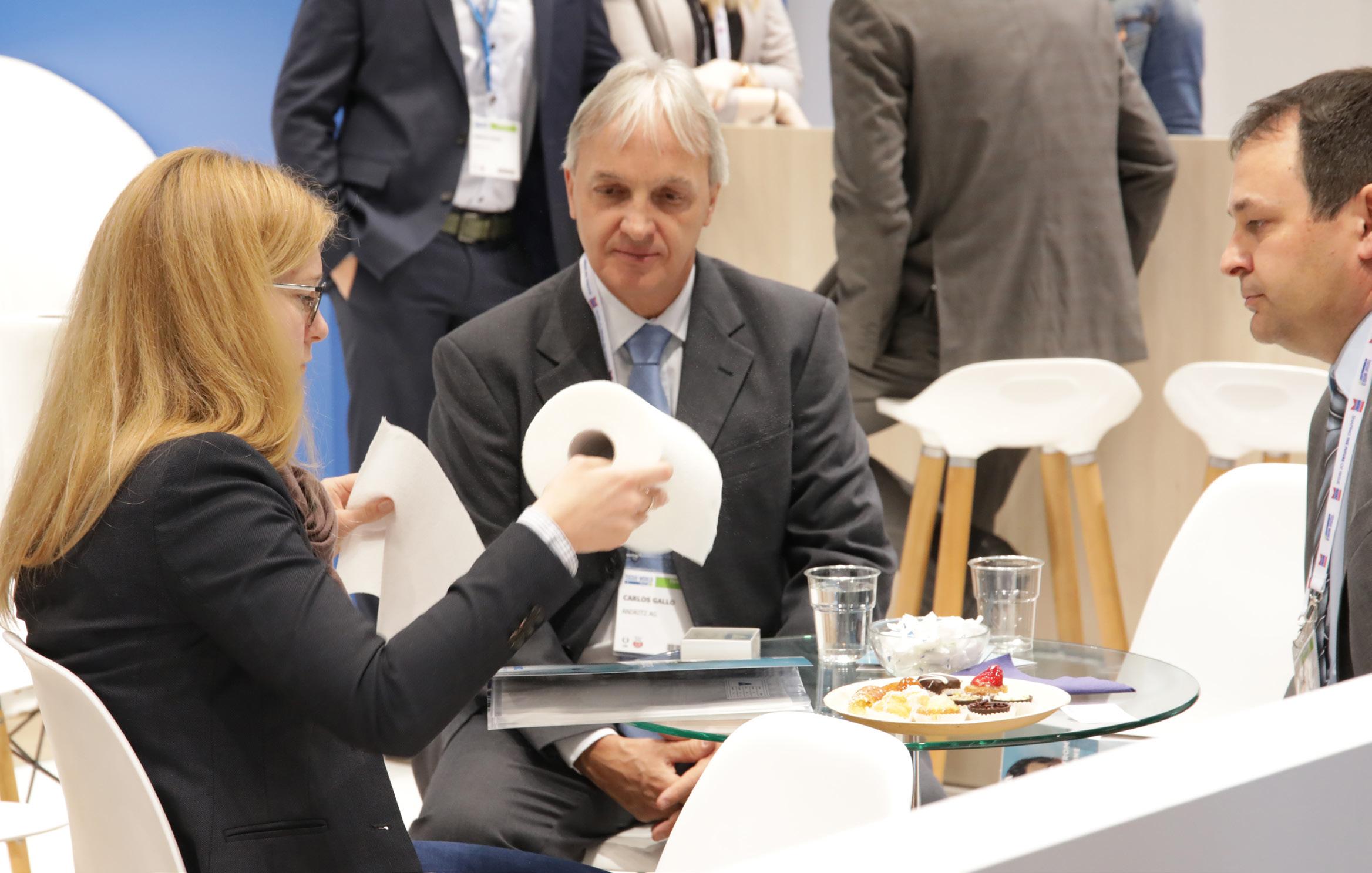
50 | July/Aug www.tissueworldmagazine.com Tissue World Magazine is free to qualified members of the tissue industry. Please visit the following link to subscribe to the printed magazines: www.tissueworldmagazine.com/printsubscription/ Sign up to the bi-monthly Tissue World Newsletter and six annual Digital Magazines here: www.tissueworldmagazine.com/ newsletter/ Andritz www.andritz.com 2 Baosuo www.baosuo.com OBC Buckman www.buckman.com 37 Convermat www.convermat.com IFC Gambini www.gambinispa.com 15 Körber Tissue www.koerber-tissue.com 32 Maxima Tissue www.maximatissue.com 45 TW Istanbul www.tissueworld.com IBC TW Miami www.tissueworld.com 29 Toscotec www.toscotec.com 19 Trebor www.trebor.com 9 Weko www.weko.net 7
SUBSCRIPTION








